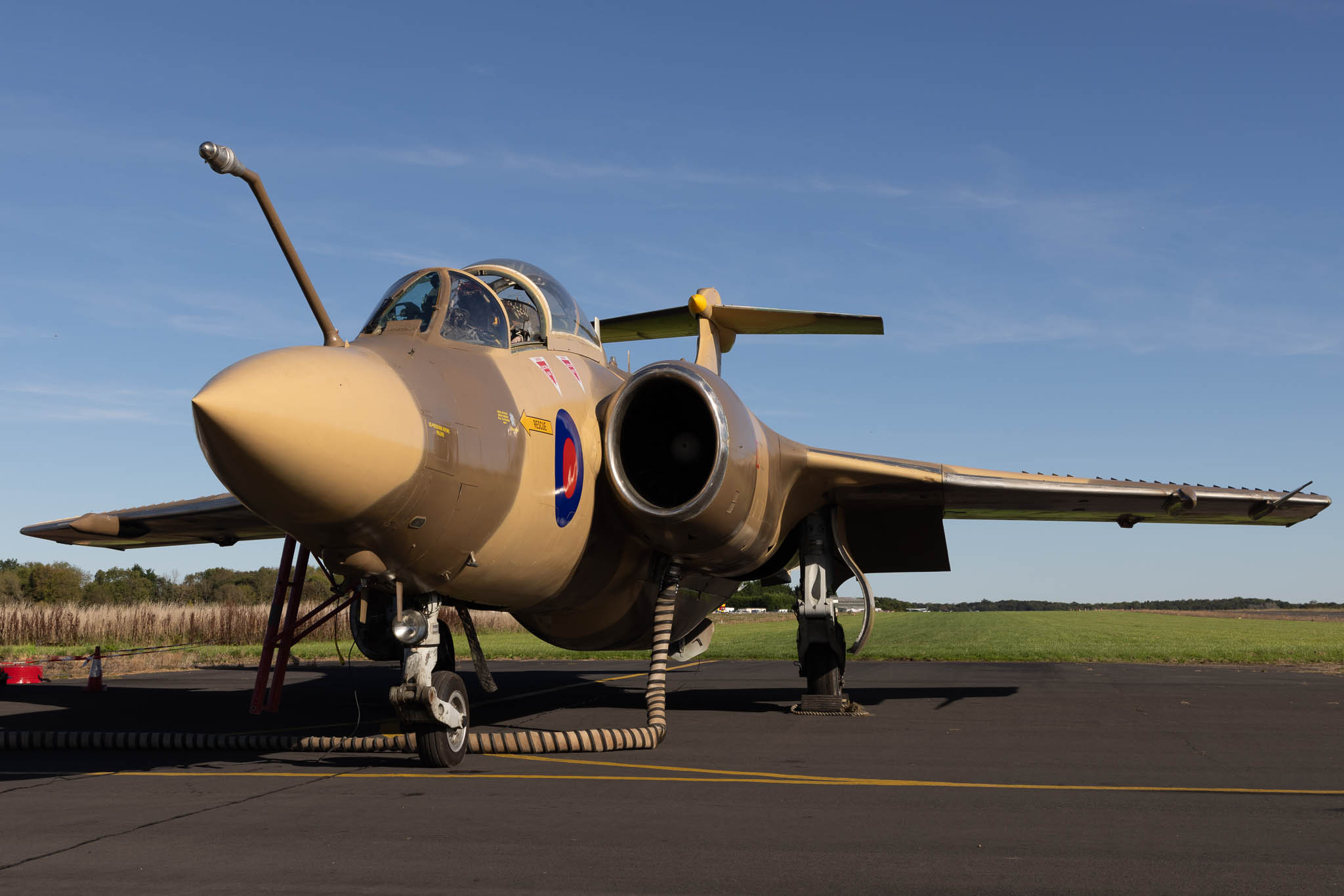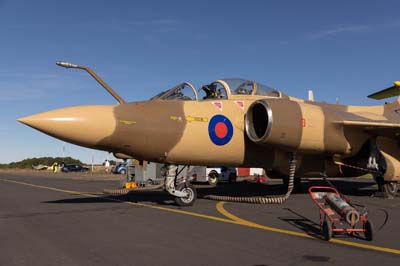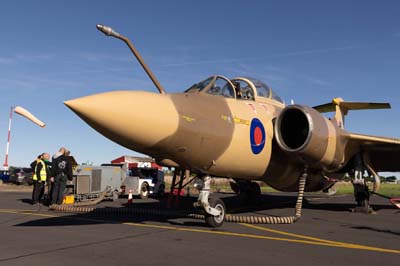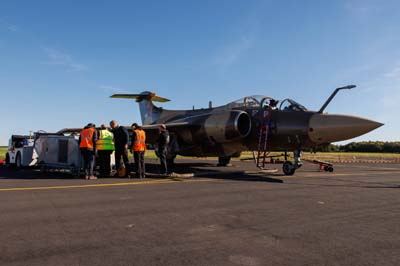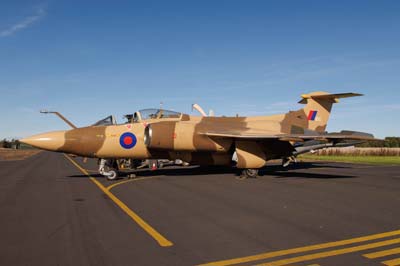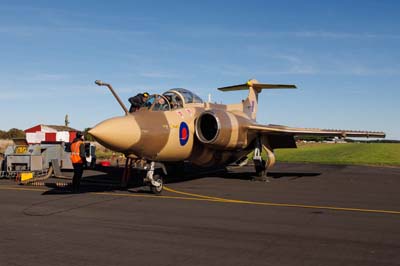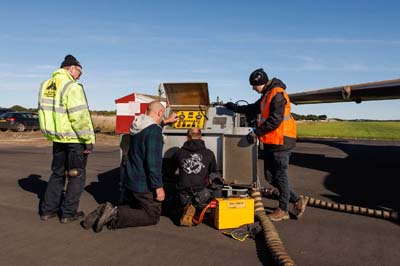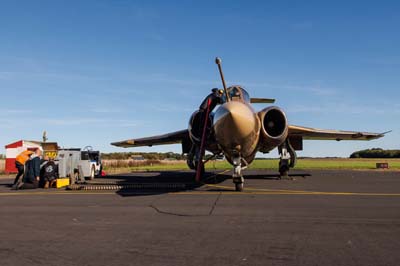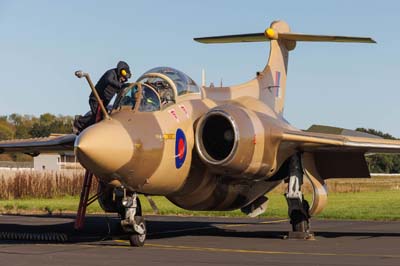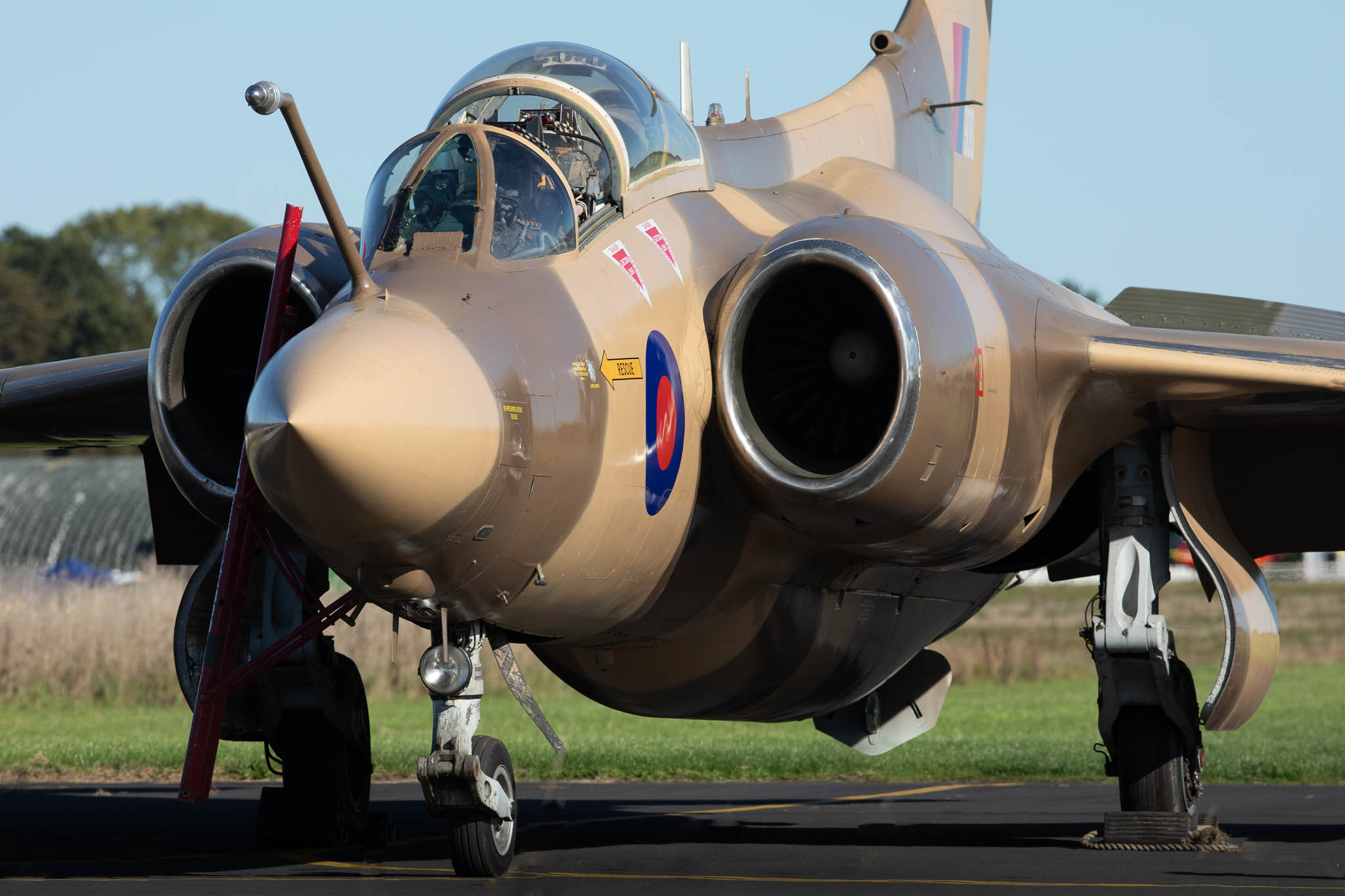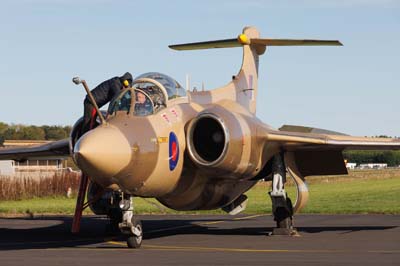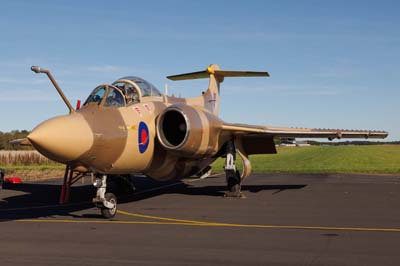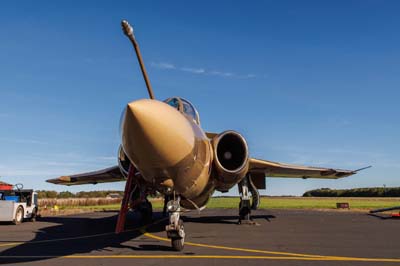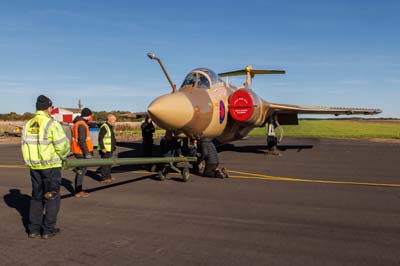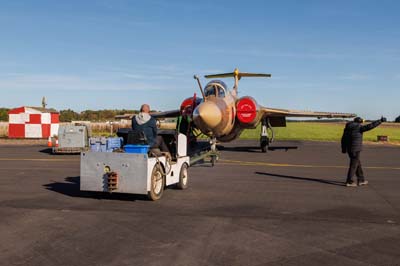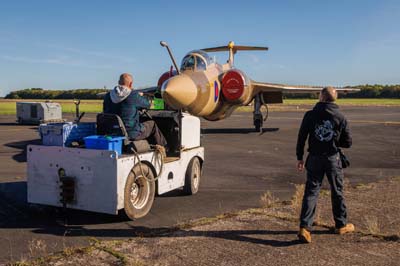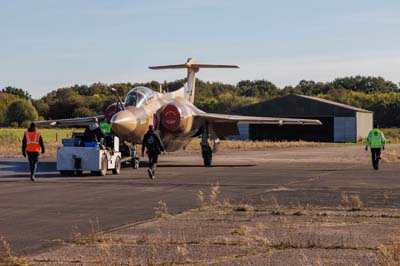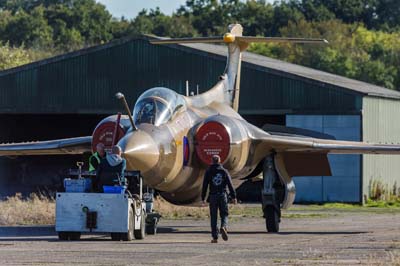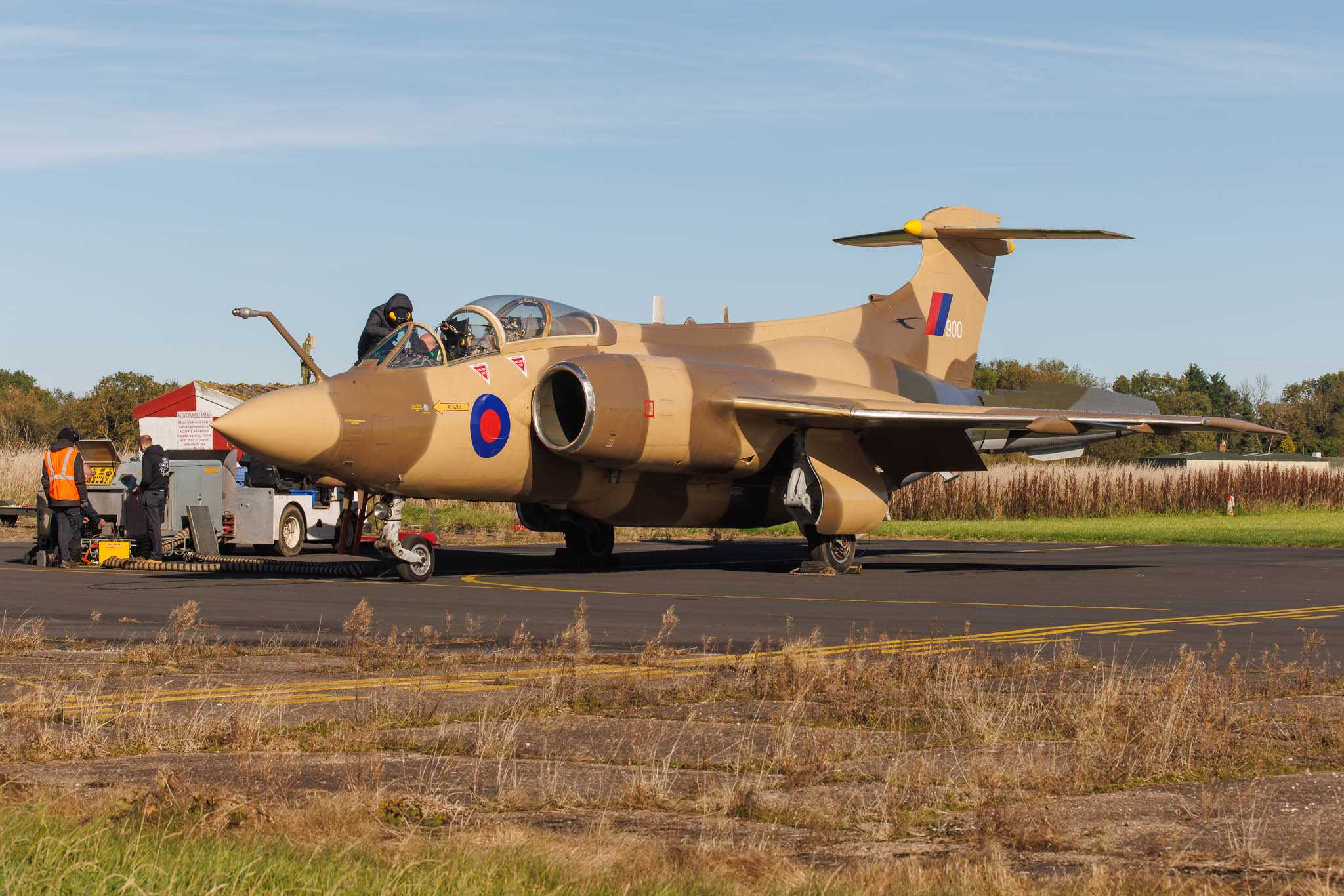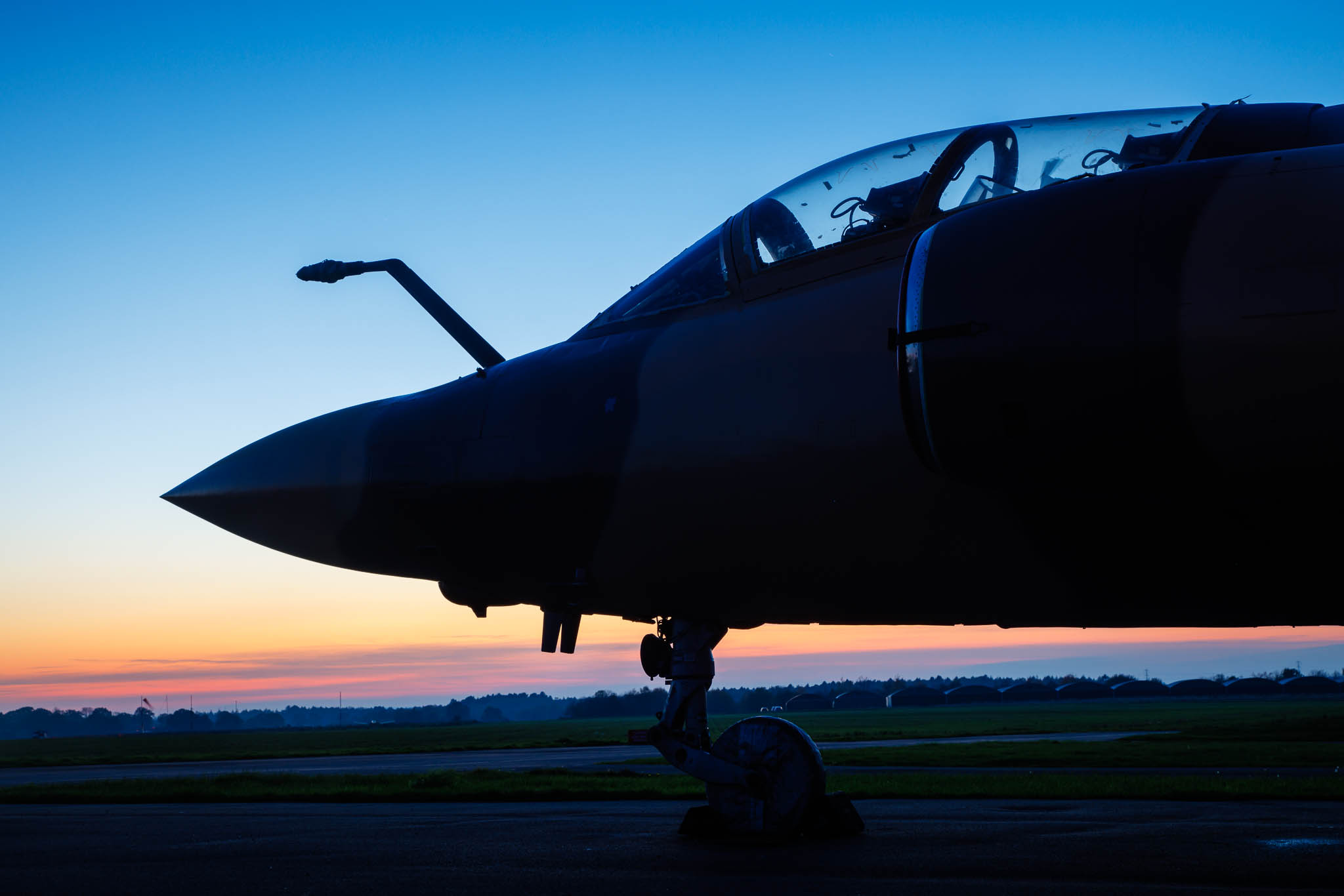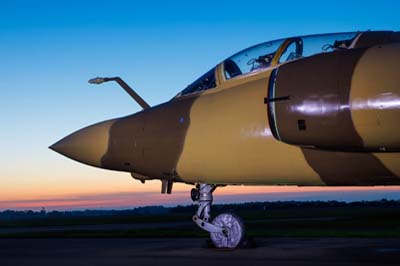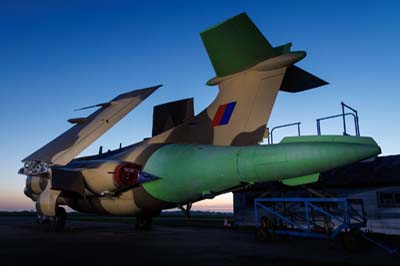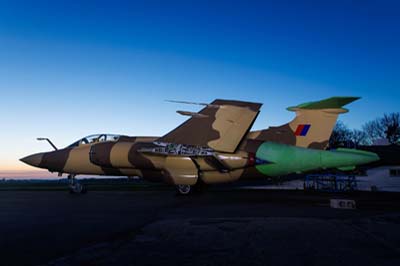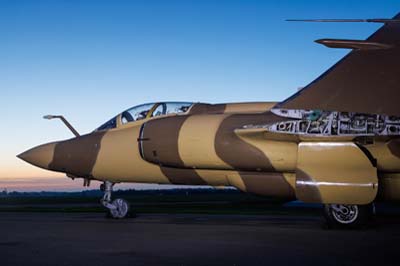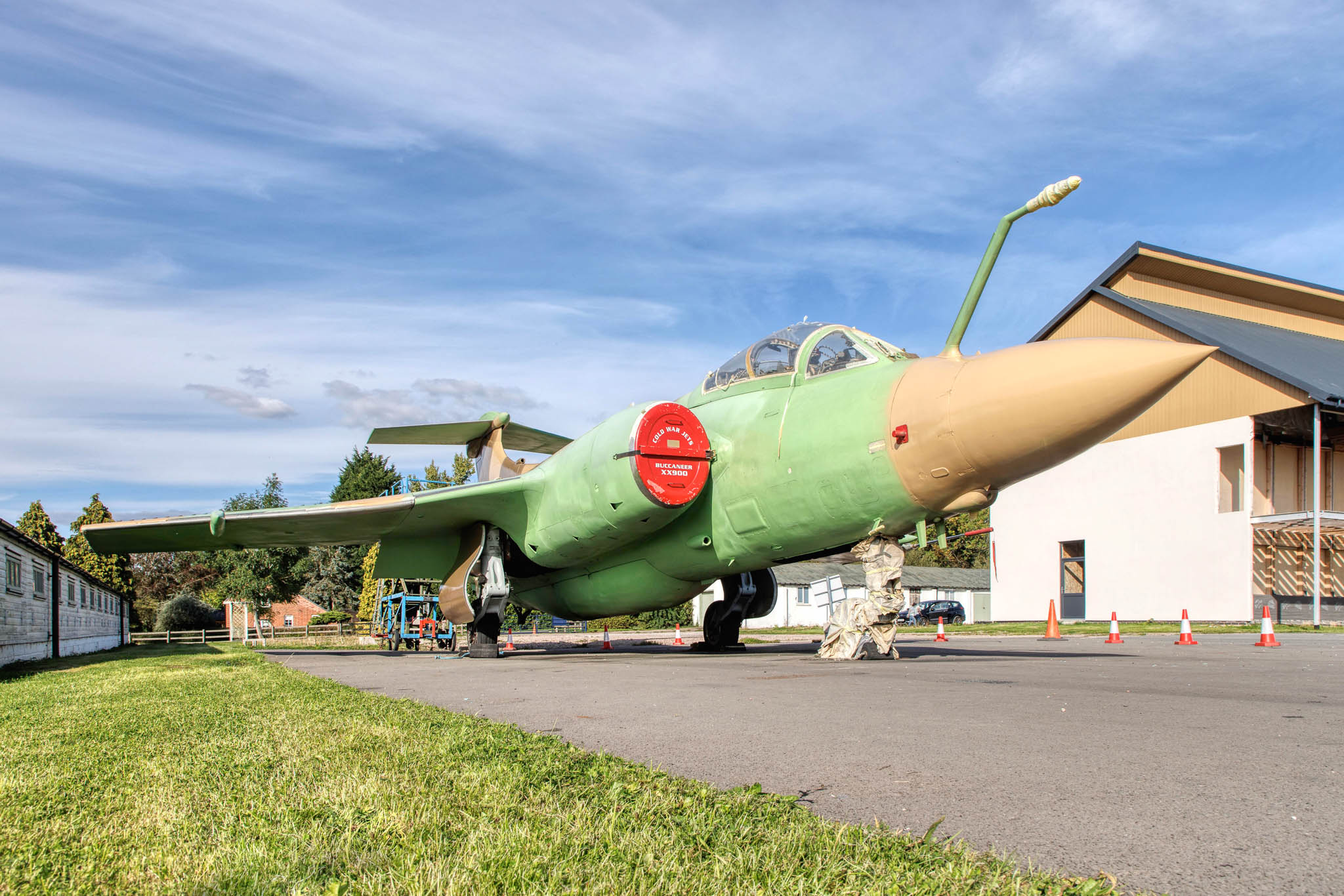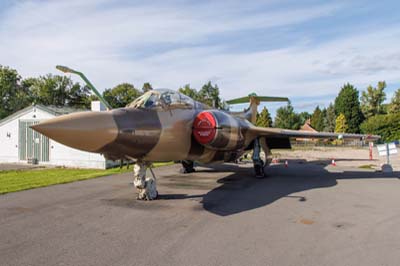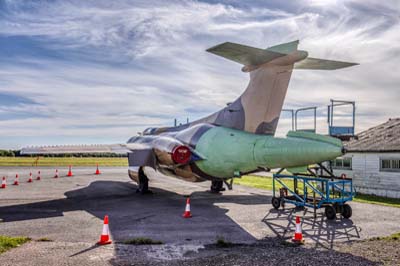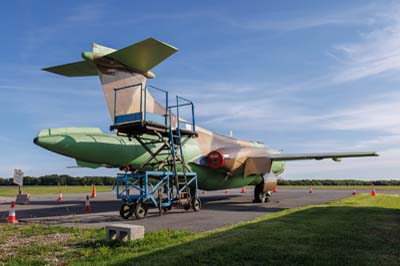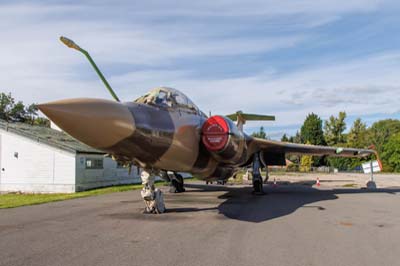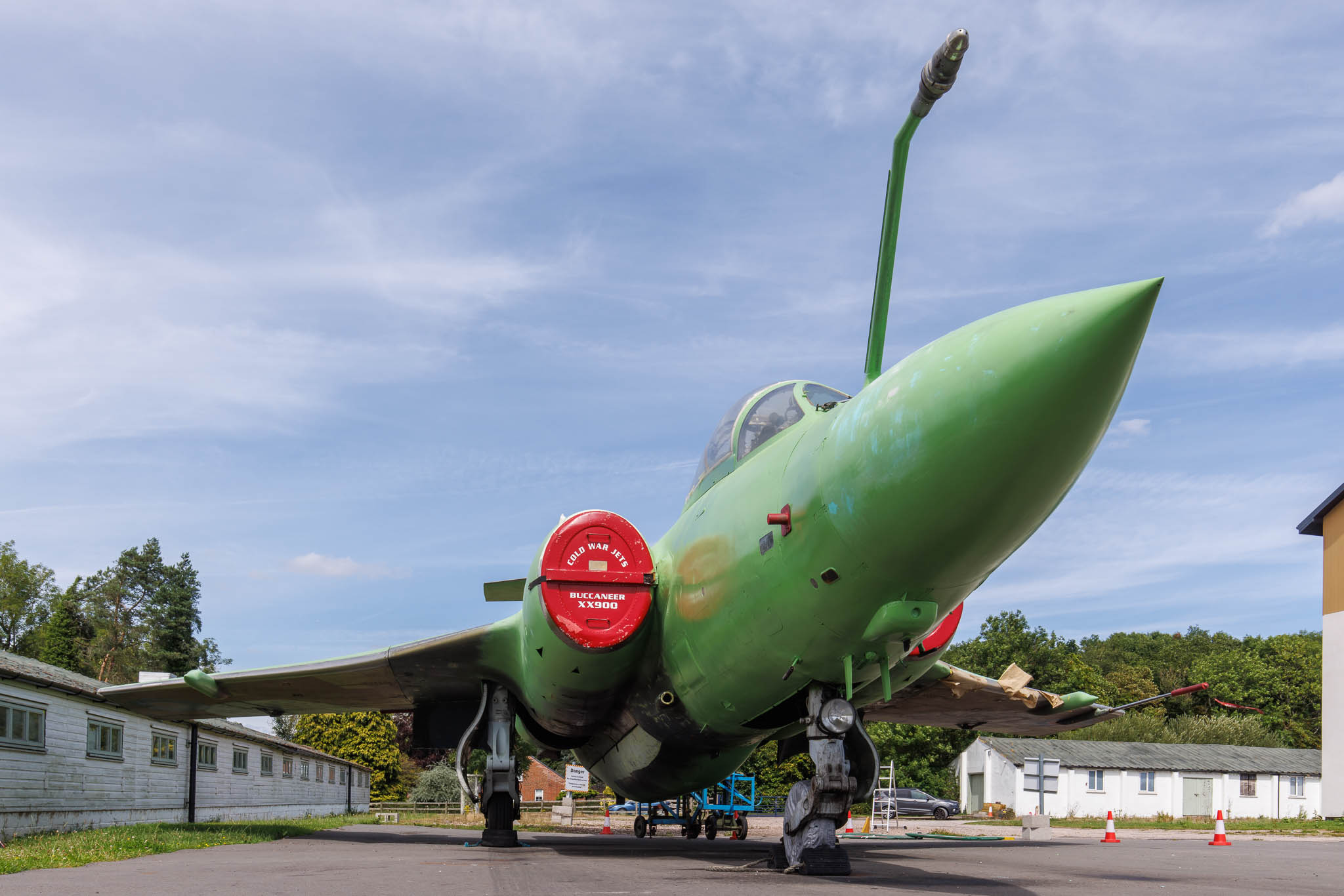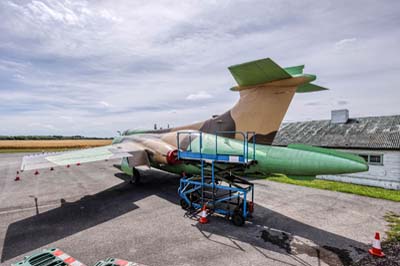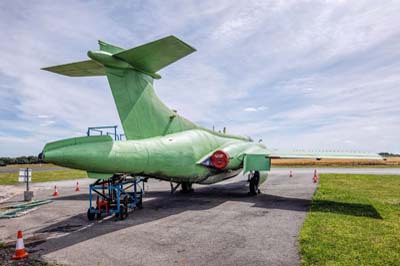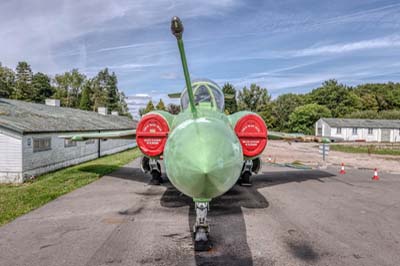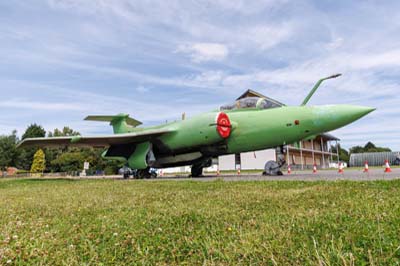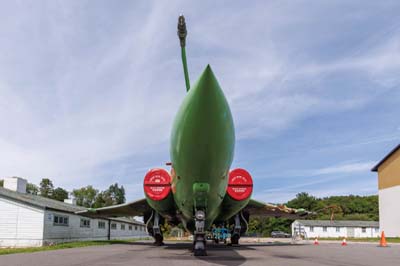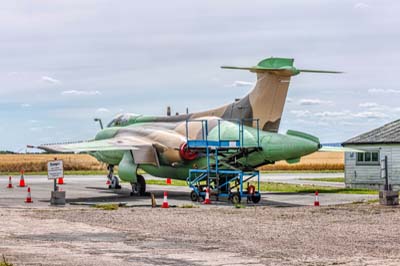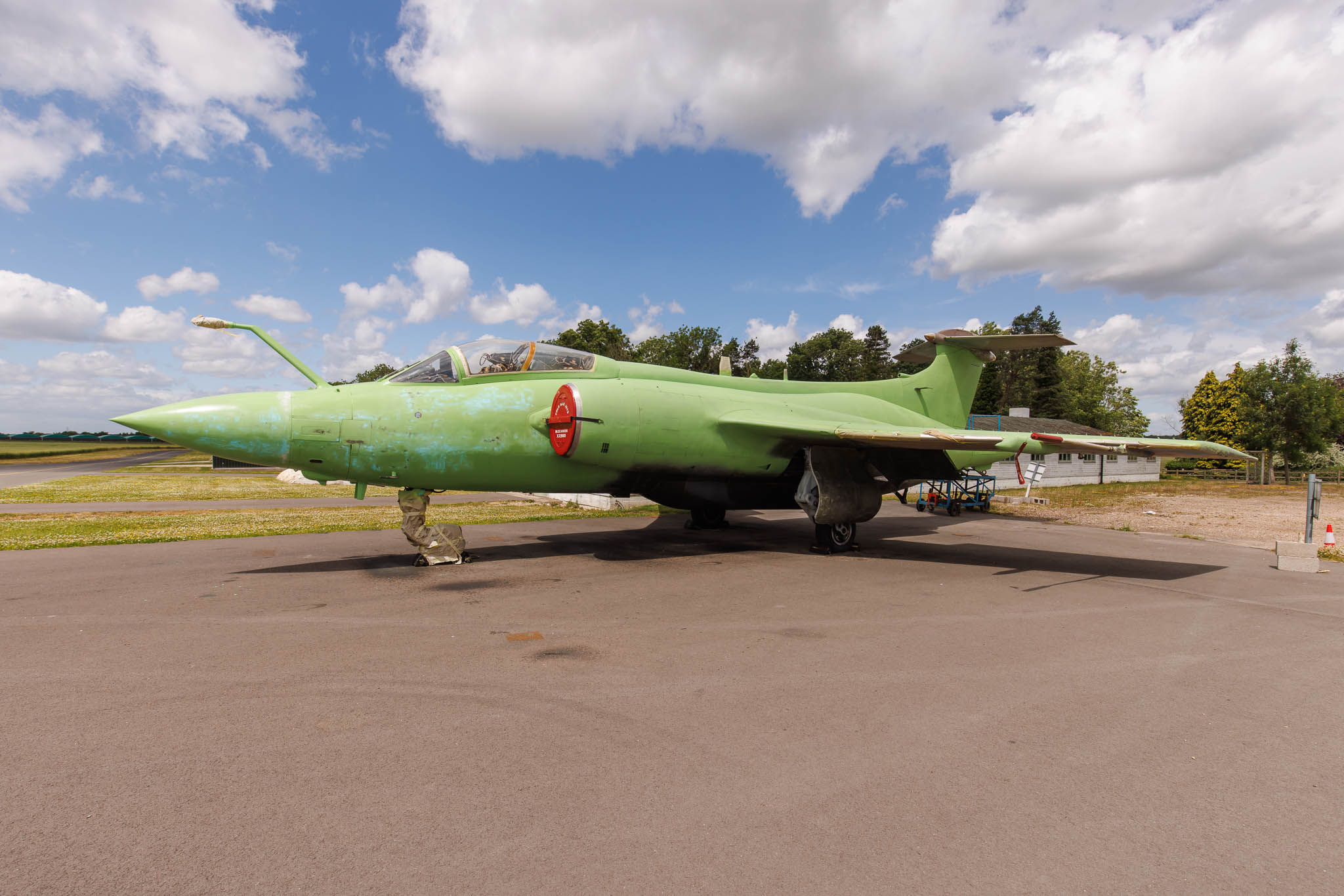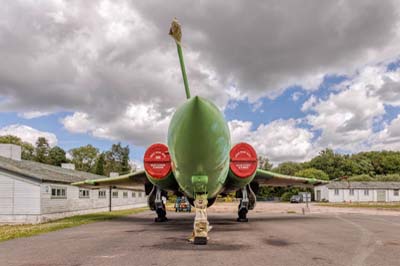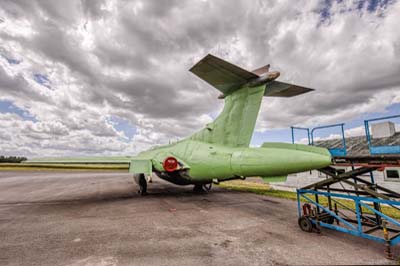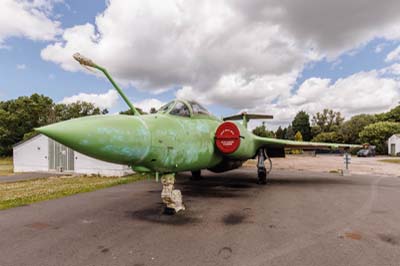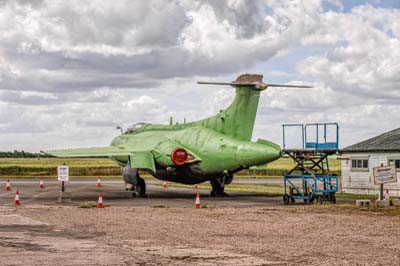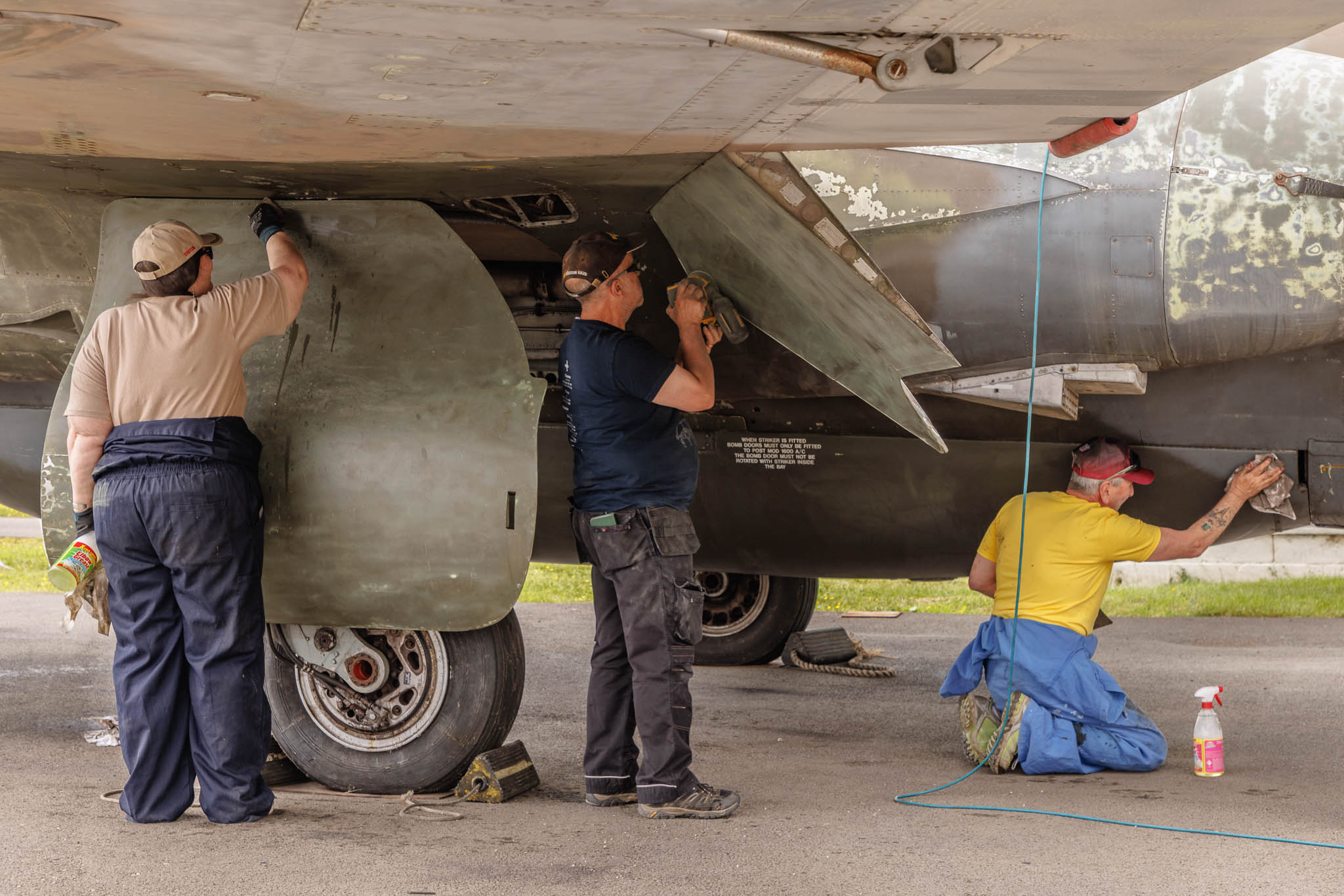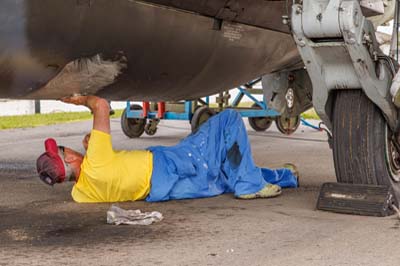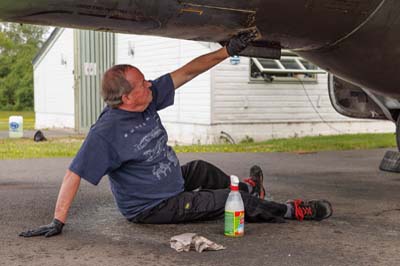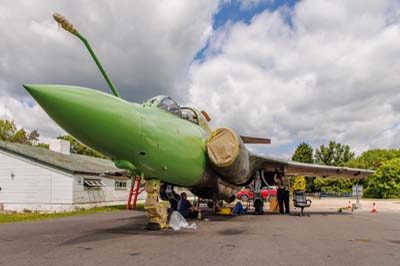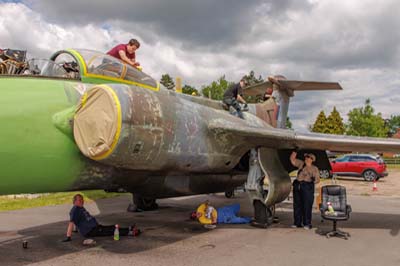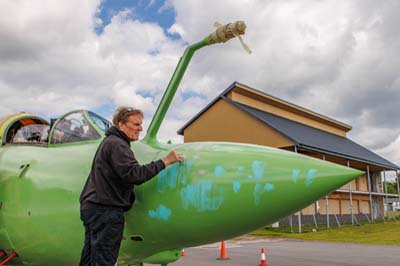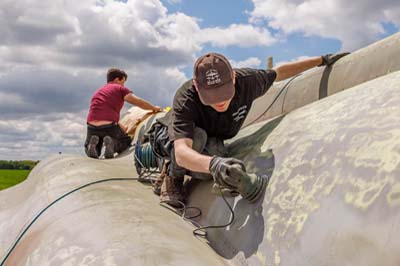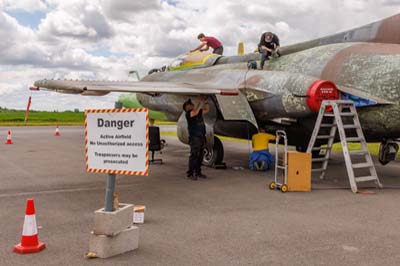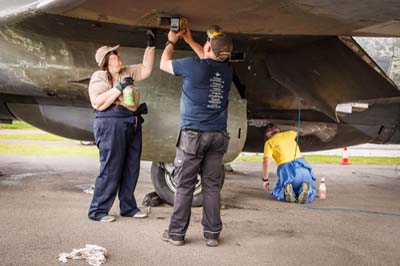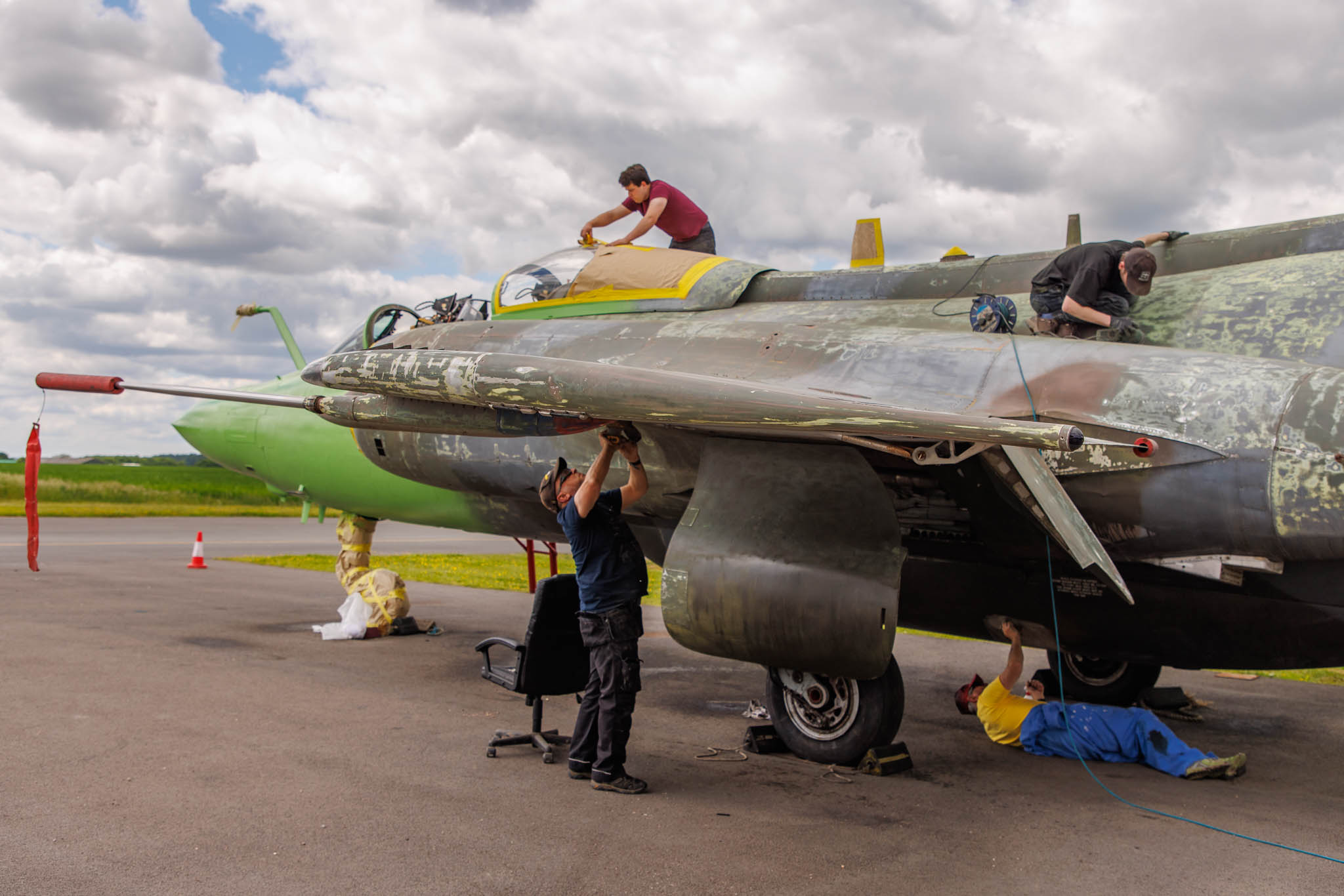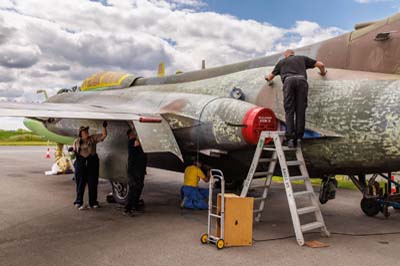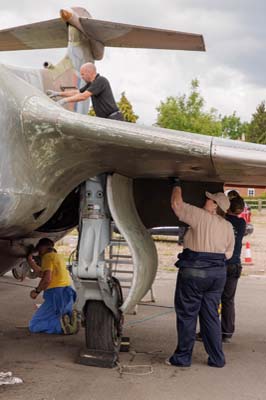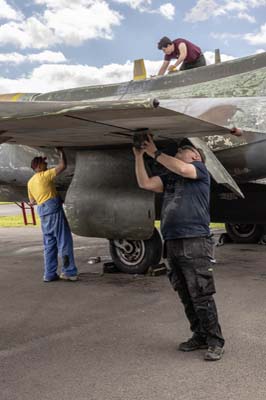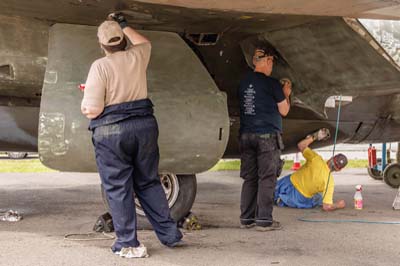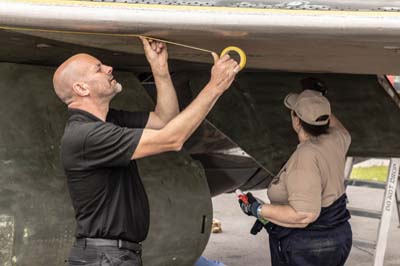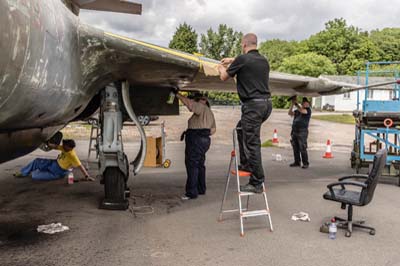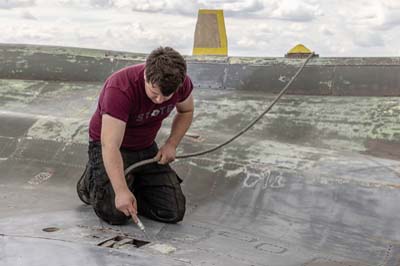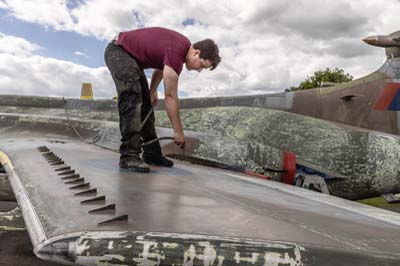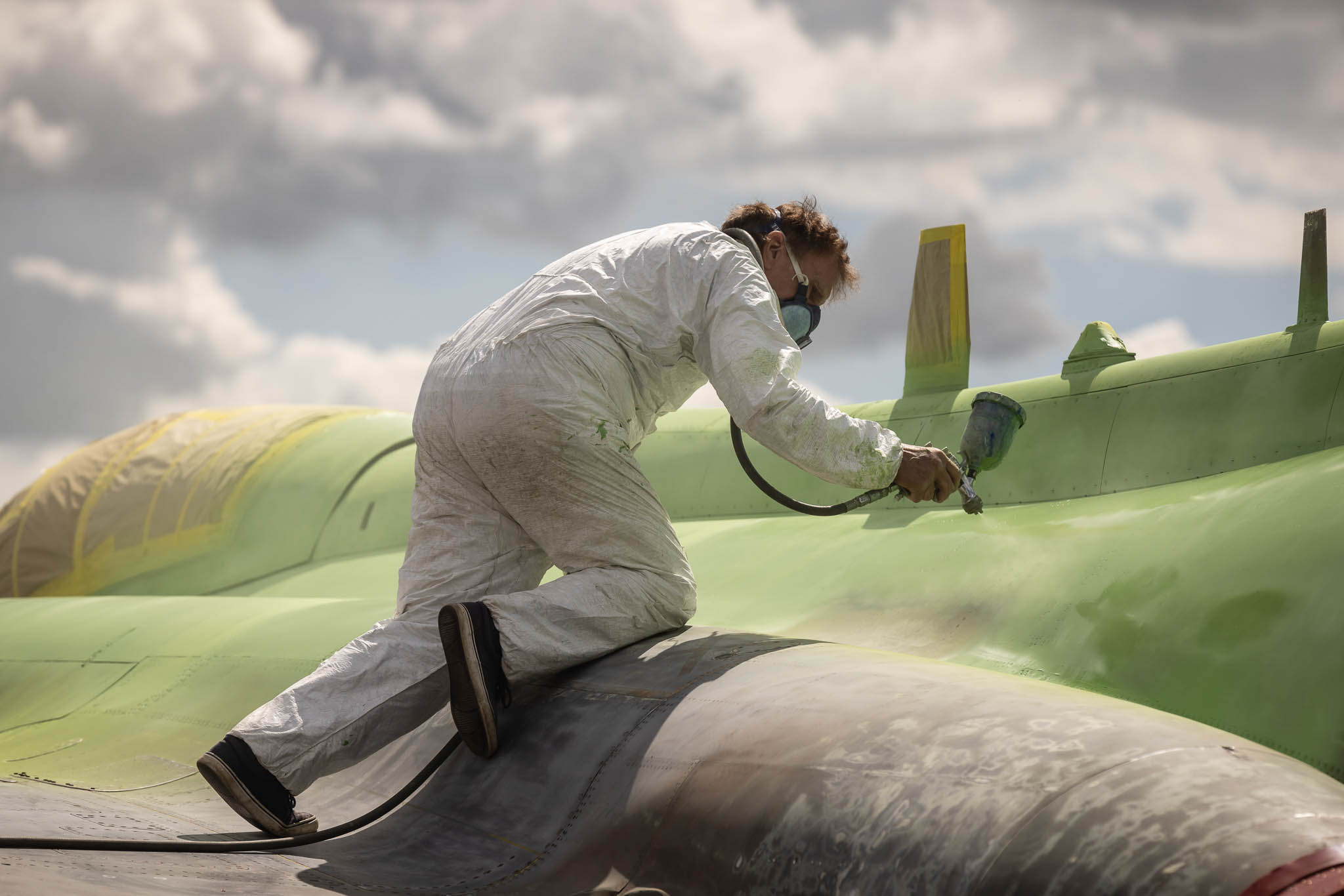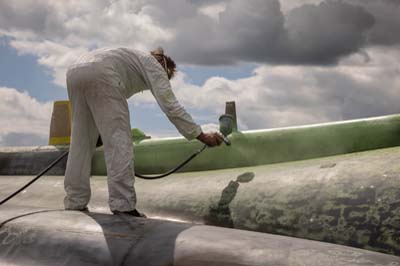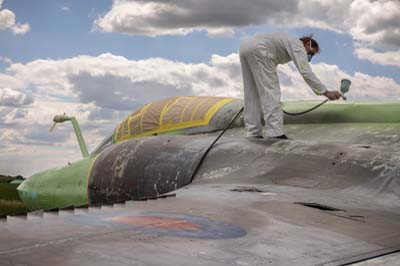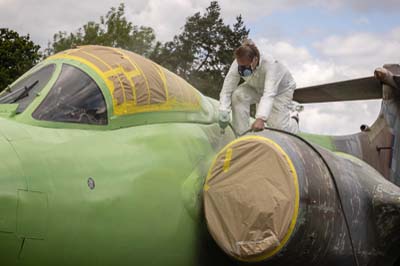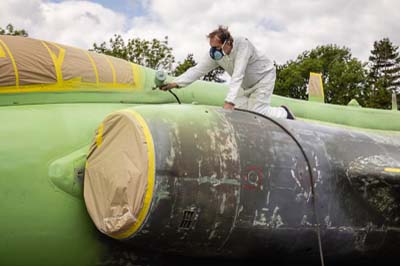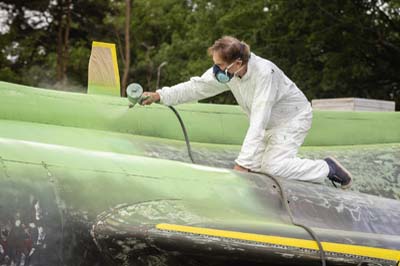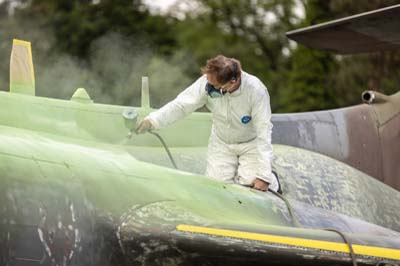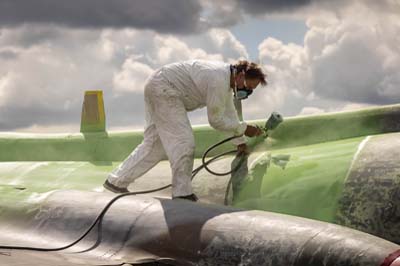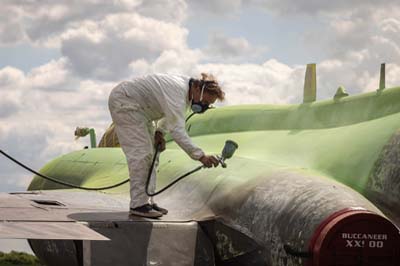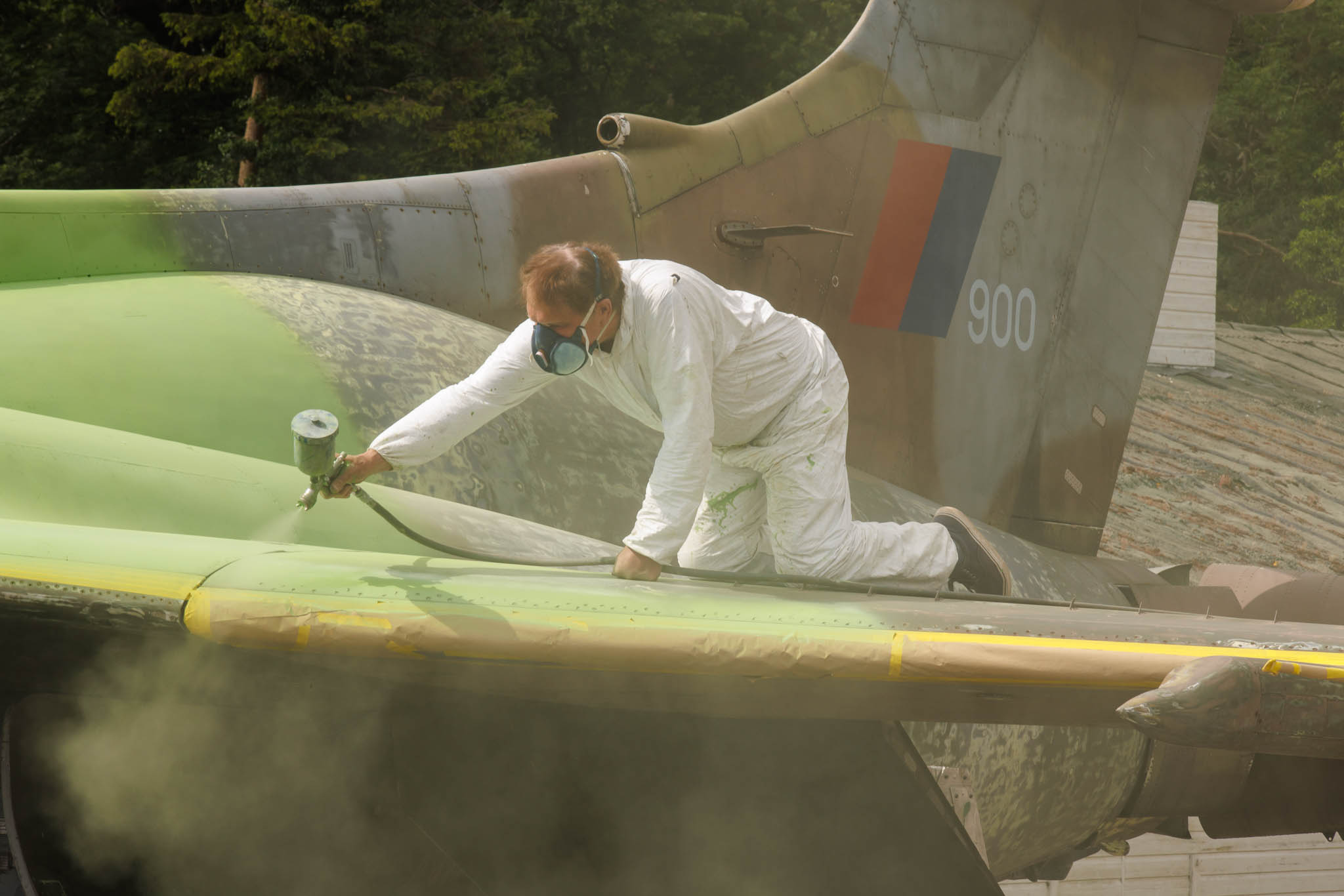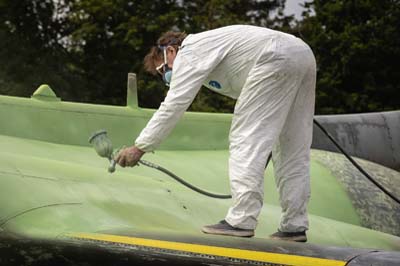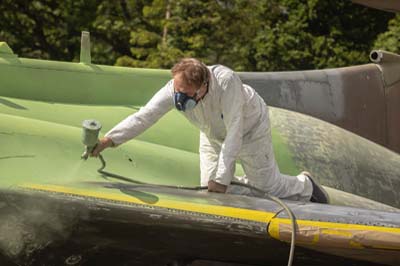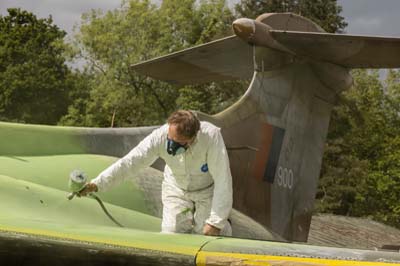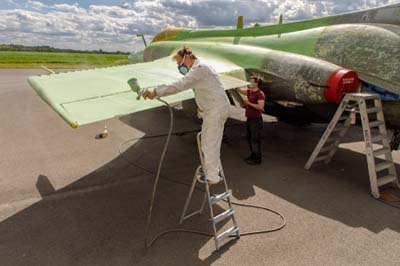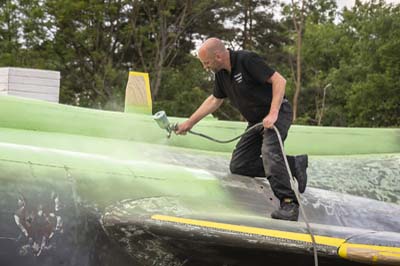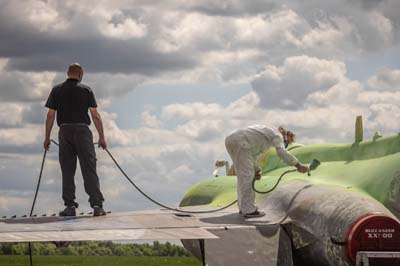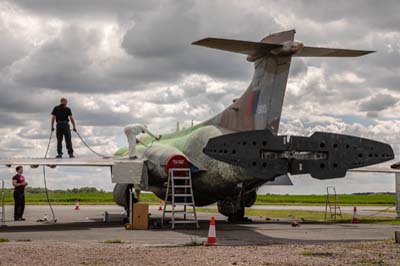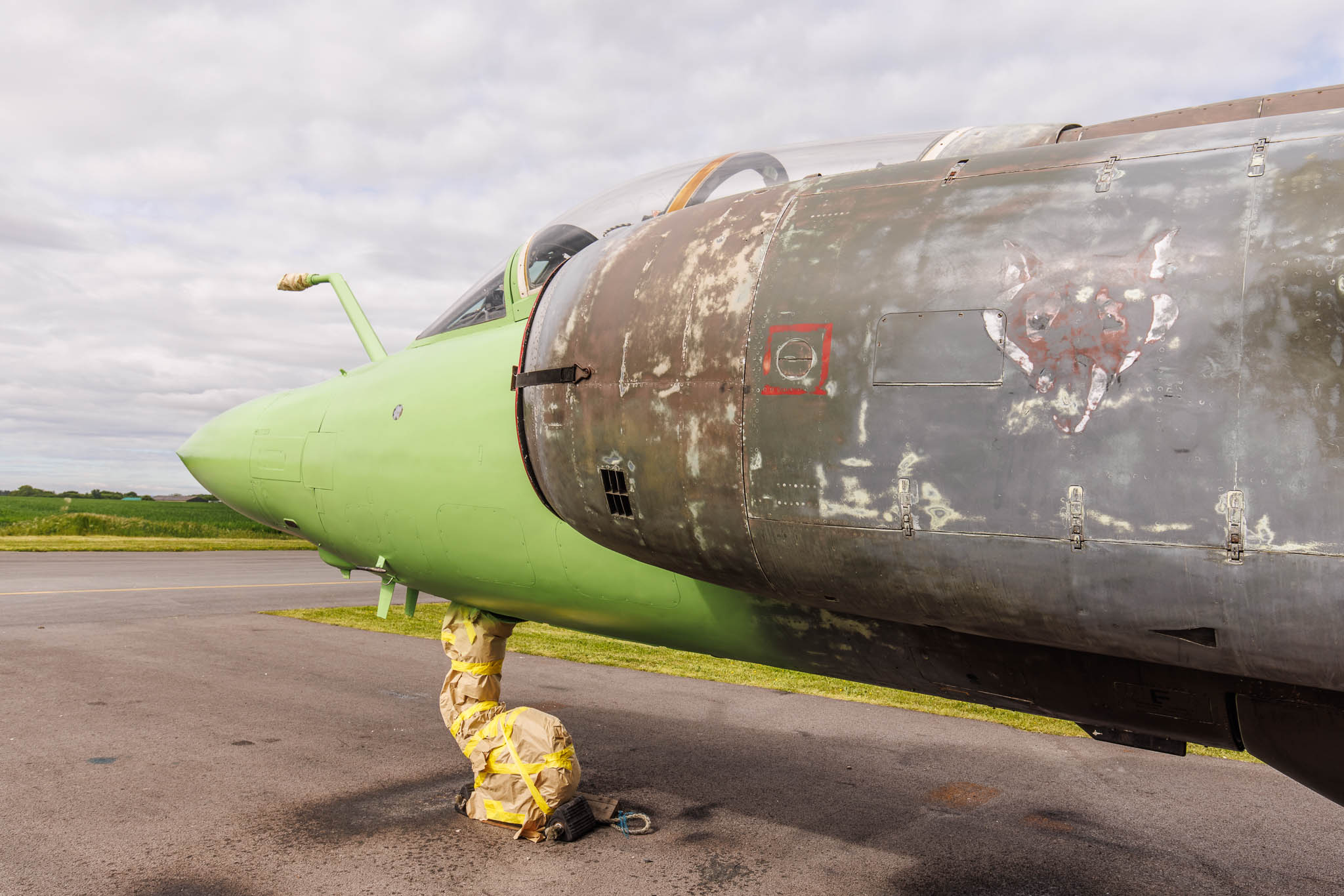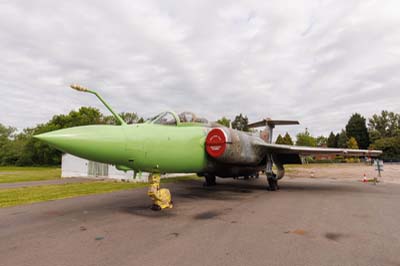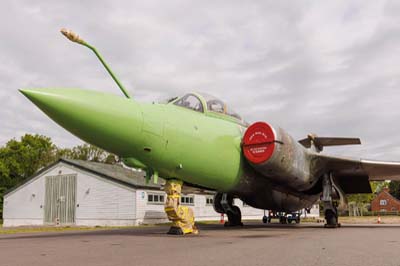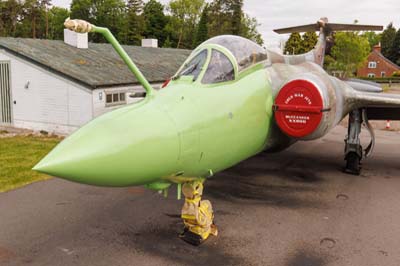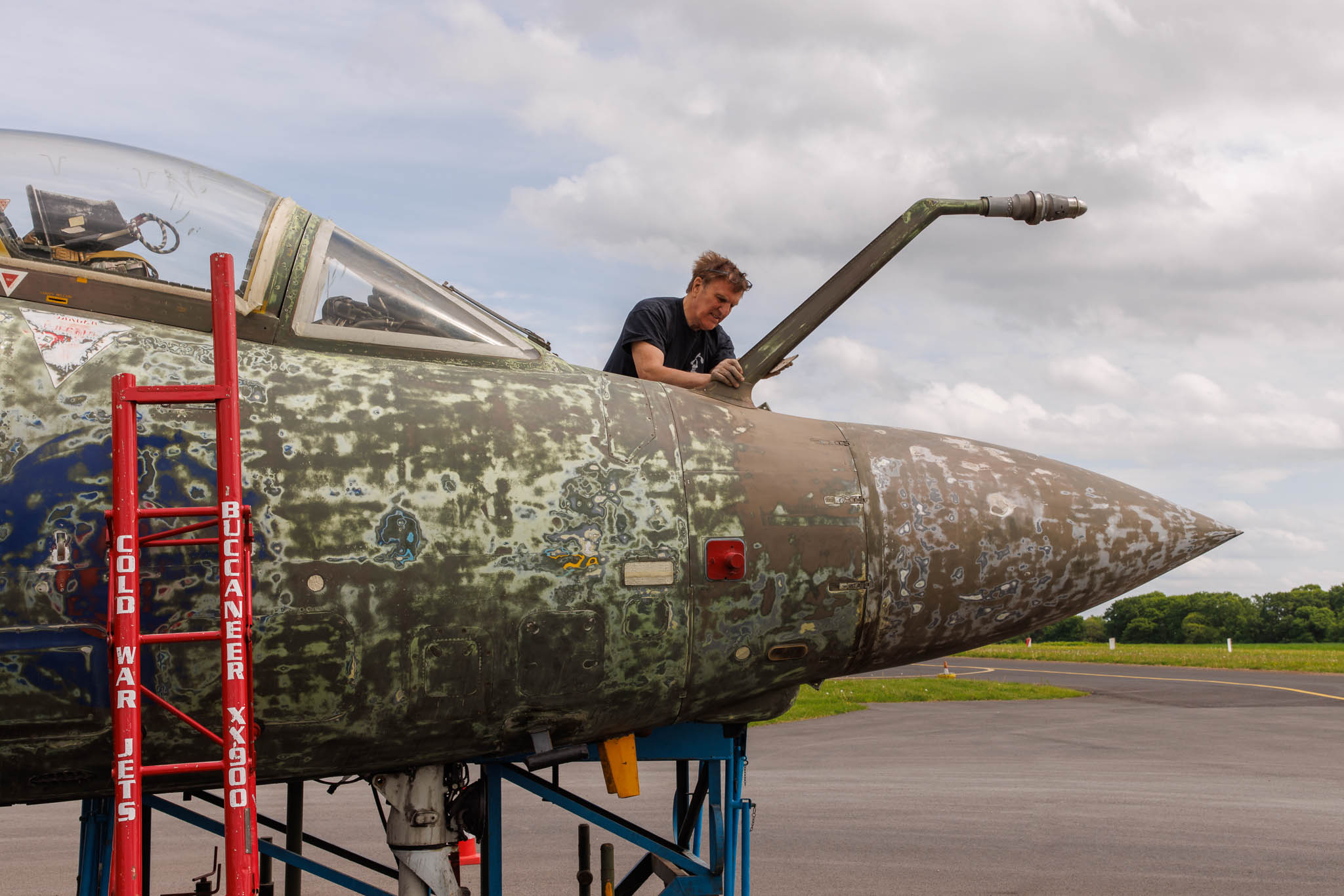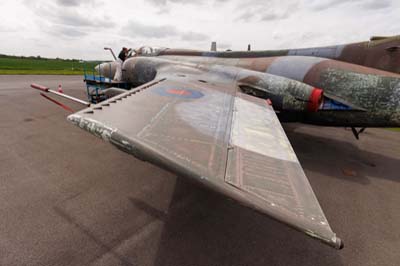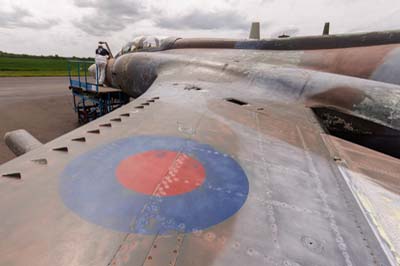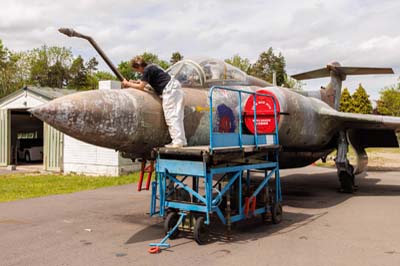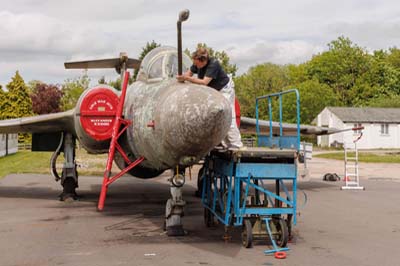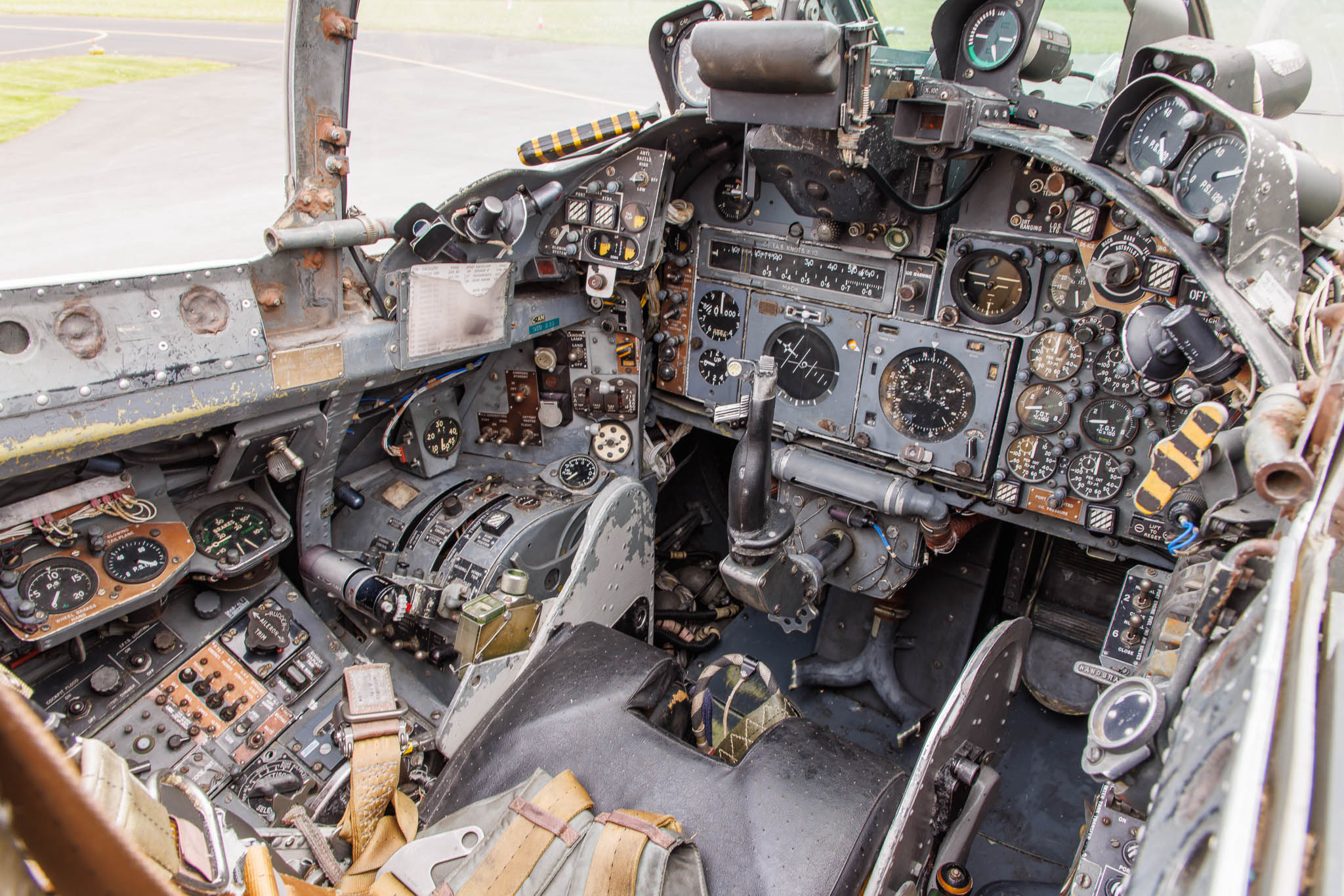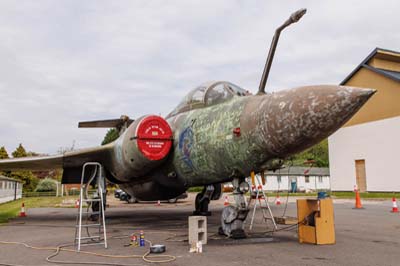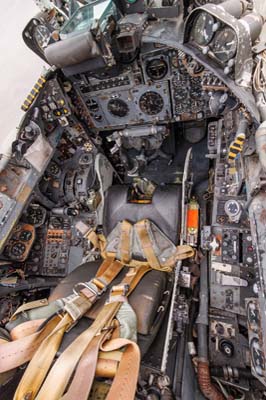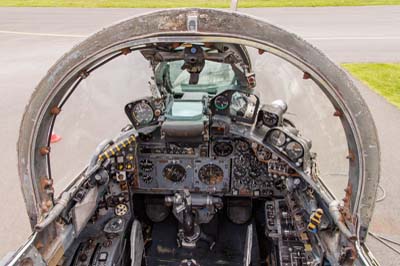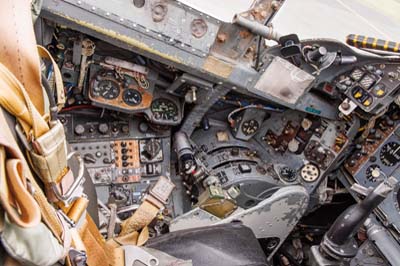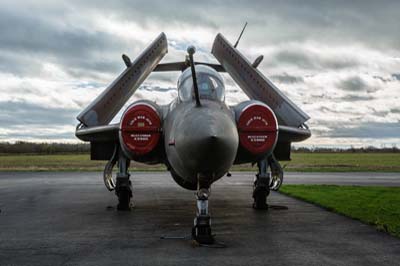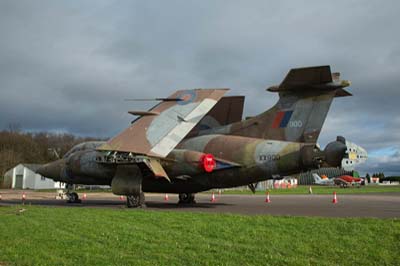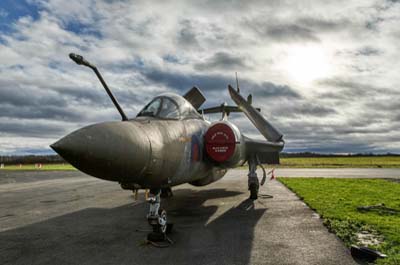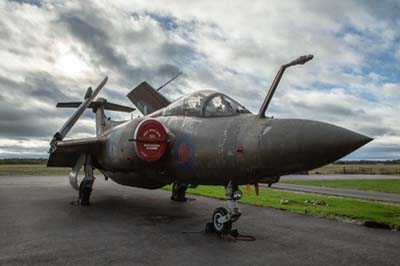Buccaneer S.2B (XX900)
Tatenhill Airfield
2020 to 2023 |
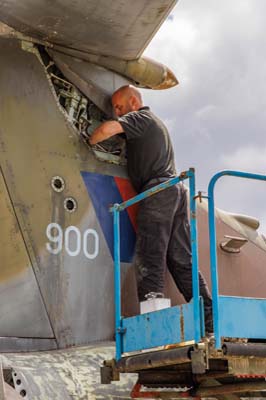 |
Lee Parker investigating an oil leak from the tail plane flap actuator. Lee's association with XX900 dates back to 1994. |
Keeping XX900 Alive

Philip Stevens reports for Aviation News details the ongoing preservation of Blackburn Buccaneer S.2B XX900, a fitting tribute to the aircraft and the pilots that flew it.
"I learned my trade on this aircraft," states Lee Parker, XX900's aircraft crew chief from 1994 to 2004 and again from 2016. "I knew very little before we collected it from St Athan [in south Wales]", where it was saved from the scrapman by David Walton, who acquired it for his expanding British Aviation Heritage – Cold War Jets Collection based at Bruntingthorpe Aerodrome in Leicestershire. "We took it apart, wings and tail, retracted the undercarriage and bought it back."
The biggest challenge then was re-attaching the wings, accomplished by aligning the wing fork so that the pin could be inserted through the two inner and one outer wing holes. Lee learned how the jet worked over the following months by consulting the manual.
The strike aircraft arrived with its tail removed, with 30 wires separated from the fin and the flap actuator. Lee's father, Denis Parker, a retired BT engineer, spent five weeks connecting them correctly.
The Buccaneer remained part of the Cold War Jets Collection at Bruntingthorpe for 26 years, regularly performing fast taxi runs to an enthusiastic paying public, before the airfield was leased out for open car storage. It meant either the days of XX900 starting up and taxiing along a runway were over, or a new airfield had to be found for the aircraft. Lee received David Walton's permission to move the Buccaneer to Tatenhill, where he is the chief engineer, to keep the jet 'live'.
|
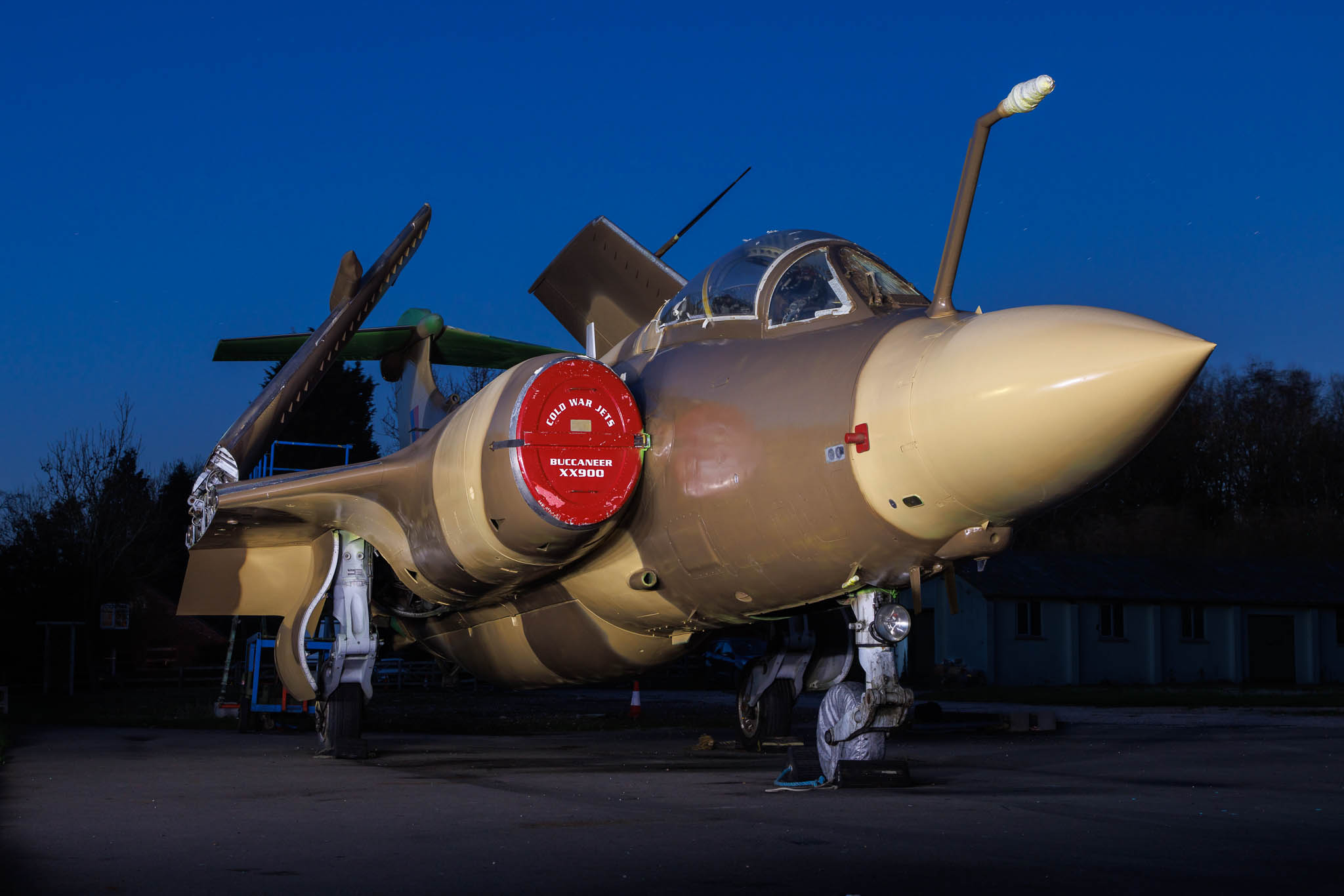 |
| Buccaneer S.2B XX900 resplendent following the reapplication of the temporary desert scheme it originally wore during Red Flag 1977-04. |
A new home
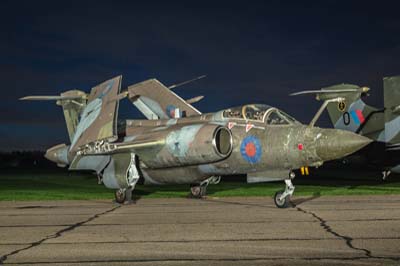 |
The Buccaneer at Bruntingthorpe in November 2015, by when the paint scheme had suffered from being exposed to the British weather for over two decades. |
On November 6, 2020, XX900 departed Bruntingthorpe on a low loader, heading for its new home at Tatenhill airfield in Staffordshire, some 60 miles away. The move, which cost £14,500, was funded by donations.
It took the preservation team six to eight months to plan the move, with the decision being taken to relocate the former RAF jet with its wings folded. To get it on the low loader the electrically selected and hydraulically operated undercarriage had to be retracted for the first time in 20 years so it came as no surprise when it did not work the first time. "We first checked the electrical systems," recalls Denis, "[and] the power to the solenoids appeared to be working, so it must be the hydraulics. We worked our way through it to find a faulty selector valve.
The valve was in stock, fitted and the undercarriage retracted." While on the low loader the Buccaneer was 6in within the maximum height allowed, but 12in too wide for UK roads, triggering the need for an expensive police escort.
Service career
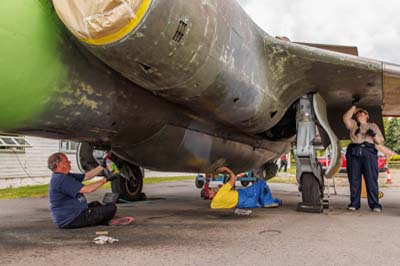 |
Dave Frost, Tony and Lynn Simpson sand down and degrease the undersides of the wings and fuselage of years of accumulated, hydraulic and engine oil and general clag, to prepare XX900 for painting. |
Buccaneer XX900 was the fifth from last of its kind on the Hawker Siddeley Aviation production line at Brough in East Yorkshire. It flew for the first time on October 22, 1976, and was delivered to RAF Honington, Suffolk, for 208 Squadron a month later. The unit had reformed on July 1, 1974, as the RAF's fourth Buccaneer squadron. It was transferred to 216 Squadron and then 12 Squadron at RAF Lossiemouth in Morayshire, Scotland, before going back to 208 Squadron by 1983. At this point XX900 took part in Operation Western Fox, firing live Martel sea-skimming anti-ship missiles against target ships off the coast of Florida. Later in 1983, she was one of six aircraft to trial the AN/ALE-40 Counter Measure Dispenser System, which released chaff or flares to protect the aircraft from missiles. The system was fitted in a hurry for Operation Pulsator, during which Buccaneers supported elements of the British Army in Beirut.
The AN/ALE-40 dispensers remain attached to each side of XX900's rear fuselage. In 1986 the avionics were updated at BAE Woodford, Greater Manchester, allowing it to carry and operate the BAE Sea Eagle antiship missile. It was back with 208 Squadron at RAF Lossiemouth by 1987 and later served with 237 Operational Conversion Unit and finally 12 (Bomber) Squadron, by when it had the original (small) wingtips of the S.1. Its last flight was on April 6, 1994, when the aircraft landed at RAF St Athan to await disposal.
Leak to leak
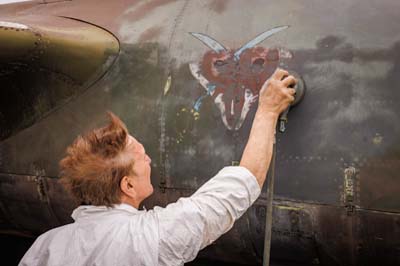 |
Steve Maltby discovered eight layers of paint on the Buccaneer while sanding down the airframe to its original primer. Here the fox head of 12 Squadron emerge from under 237 Operational Conversion Unit's crossed swords. |
The ongoing preservation of XX900 has only been made possible thanks to the dedicated hard work of a small team. It includes Lee's brother Simon and son Ben, as well as his father, Denis, plus Chris Kennedy, a health and safety officer and volunteer, who learned how to rebuild the air starters as one of his first tasks.
Dave Frost, another key member of the team and an engineer in the RAF for 26 years, worked on Buccaneers for seven years at RAF Laarbruch in West Germany and RAF Lossiemouth. He says: "I actually worked on XX900 – I remember it well, along with XX901. They were the last two Buccaneers manufactured – these two then did not leak!" Today, even while just sitting on the tarmac, XX900 will develop a new oil leak without any apparent reason, whether it be from the tail plane flap actuator or the main wheel hydraulics. Another former Buccaneer engineer joked: "I recall we were more worried when they weren't leaking. Usually meant they were empty! "Walking around XX900, Dave points to the tyres: "In service these tyres would perhaps last just a couple of months, due to the spirited landings. They always hit 4g on the g meters on landing. This was because the Buccaneer was designed for low flying with 'ground effects', so you had to force the aircraft down for the landing."
Dave recalled that when XX900 was acquired it did not have a radio or radar installed, as they were retained for other jets and replaced with ballast for its final flight. The weapons systems and radar altimeter dial were also missing. While the other dials are still in place in the front, controls in the rear seat are a little sparse.
|
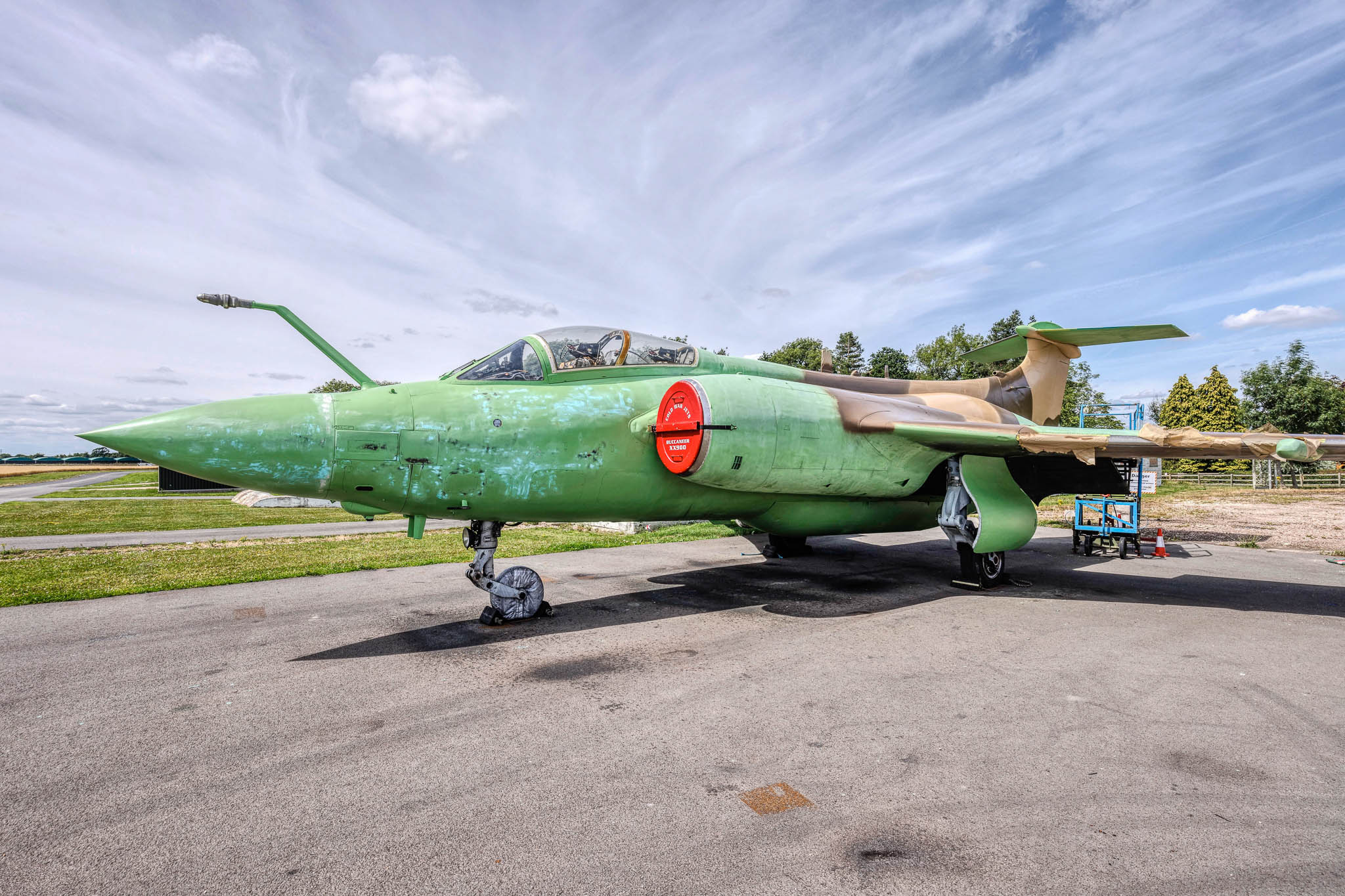 |
| The Buccaneer with the two-tone sand camouflage painted on the upper wing surfaces, with the lime green primer and filler already applied to the rest of the airframe. |
The plan
After completing the move the focus of the team was, firstly, to keep the nearly 50-year-old former RAF jet in ground running order and, secondly, to repaint it completely. Since its retirement from service in 1994 the paint scheme has suffered during nearly 20 years of being exposed to the elements. Since the move there have been many offers of assistance. Steve Maltby, an aircraft owner at Tatenhill and formally with Air Livery, offered to do the repainting, either by spray or rollers. But even before painting could start, the aircraft required a lot of sanding down, degreasing and filler preparation.
A long list of equipment, including a towbar, an air connector, jack and services trolley, Hants & Sussex STAD air starter, ground power unit, hydraulic servicing rig and aircraft tug, were all sourced or refurbished in the six months following the move, bringing a much needed 'anti-det' (anti-deterioration) engine run closer.
Describing the plans for engine running at the time, Lee Parker stated: "It has 1,000lb of fuel in her now, we intend to engine run every six weeks. The RAF ran them every 14 days. We must stretch it to every six weeks due to the cost. When it was left for nine months it still started up straight away," he added with a smile.
To keep the vintage jet in running order, to secure XX900's long-term survival and operation, on-going funding is required, which has thankfully continued through donations. While 'anti-det' engine runs continued on a more or less regular basis, keeping the jet in working order by running all hydraulics and operating flying control surfaces, the team also identified faults and parts that needed servicing and repair.
|
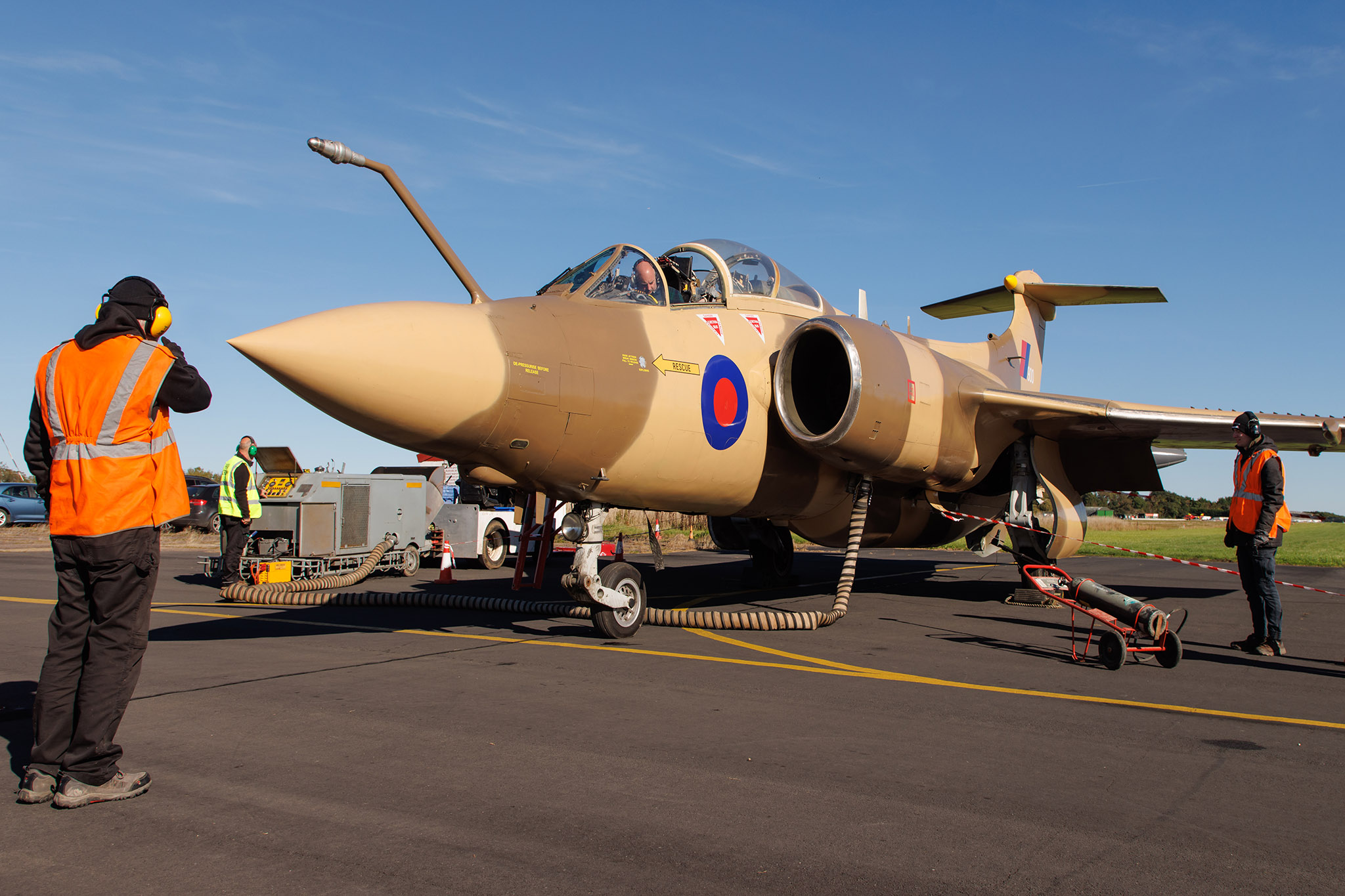 |
| Fully painted in the Red Flag sand camouflage, complete with national markings and stencils, the engines of Buccaneer XX900 are about to be started during one of the 'anti-det' runs undertaken every six weeks. |
Back to the desert!
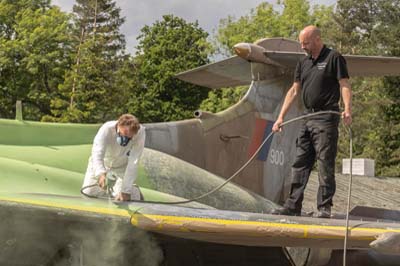 |
Steve Maltby, formally with Air Livery, spray painting the lime green primer to the upper wing surfaces, with Lee Parker assisting on the air line. After the primer was applied to the whole aircraft, filler was used to cover any dints on the airframe. |
A major announcement was made in April 2022 following the arrival of the primer paint, sponsored by local pilots, and the topcoats, generously funded by David Walton. The decision on which paint scheme to apply had been made 18 months earlier, but was kept under wraps until then. The team wanted an authentic paint scheme that XX900 had worn in service, but one unlike any other surviving Buccaneer. This was a tall order considering there are 24 Buccaneer survivors in the UK, although only five or six are capable of fast taxi runs.
To some surprise, it had been decided by the team and David Walton to repaint XX900 in the temporary, 'nearly all-over' desert camouflage scheme it received for its participation in a 1977 Red Flag exercise held at Nellis AFB, Nevada. Just four of 208 Squadron's ten Buccaneers were repainted in the camouflage, and only for the exercise.
Over the following months, many hours of arm-aching sanding and degreasing of years of accumulated hydraulic and engine oil, and removal of general clag stuck to the jet's surfaces was required to prepare the aircraft for the lime green primer. By then, the team had been now bolstered by new volunteers Tony and Linda Simpson.
After joining the RAF in 1978, Tony 'Biggles' Simpson worked as a flight line armourer on Buccaneers with 216 Squadron at RAF Honington. "XX900 was the first aircraft I ever touched," says Tony, who was among the ground crews amalgamated with 12(B) Squadron when 216 Squadron disbanded in August 1980, moving up to RAF Lossiemouth with XX900. Years later he came across XX900 at Bruntingthorpe and remembered her instantly. He had a model of XX900 that his then wife-to-be had accidentally broken the inflight refuelling probe on. "It was wife Linda that spotted XX900 when driving past Tatenhill; she took me here last week as a surprise, it was a tearful moment. I always loved Buccaneers; I did 16 years on the Tornado, but the 'Bucc' was my favourite."
He asked what was going on and offered his help, explaining: "I told them of my past history, and they said I was more than welcome." Grinning he says: "I am now the armourer for XX900… if they need to remove the seats, I still have some of the manuals. This is the second time we have been down with Linda; today we are sanding down and cleaning the aircraft ready for the undercoat."
On a May bank holiday in 2022 a concerted attempt by a working party prepped the port wing underside, port fin and spine, port tailplane and starboard main gear door. With the upper surfaces already prepped, it was ready to receive the primer. A week later the port engine was dry cycled to build hydraulic power to close the air brakes, so they could be sanded down.
David Walton supplied 1,000 litres of aviation fuel (500 litres each in tanks 3 and 4) – apparently drained from the tanks of one of the RAF's Lockheed TriStars flown into Bruntingthorpe several years earlier – which was pumped into tanks three and four.
With the primer fully applied to the whole aircraft and filler used to mask dints on the airframe, it was time to tape up the aircraft ready to apply the sand camouflage. In addition to the repainting, maintenance tasks including the refurbishment of the front ejection seat and servicing of the main aircraft jacks and 'anti-det' runs, also continued to the end of 2022. Seemingly what a Martin-Baker seat can do in seconds took about two hours under the guidance of Tony Simpson.
|
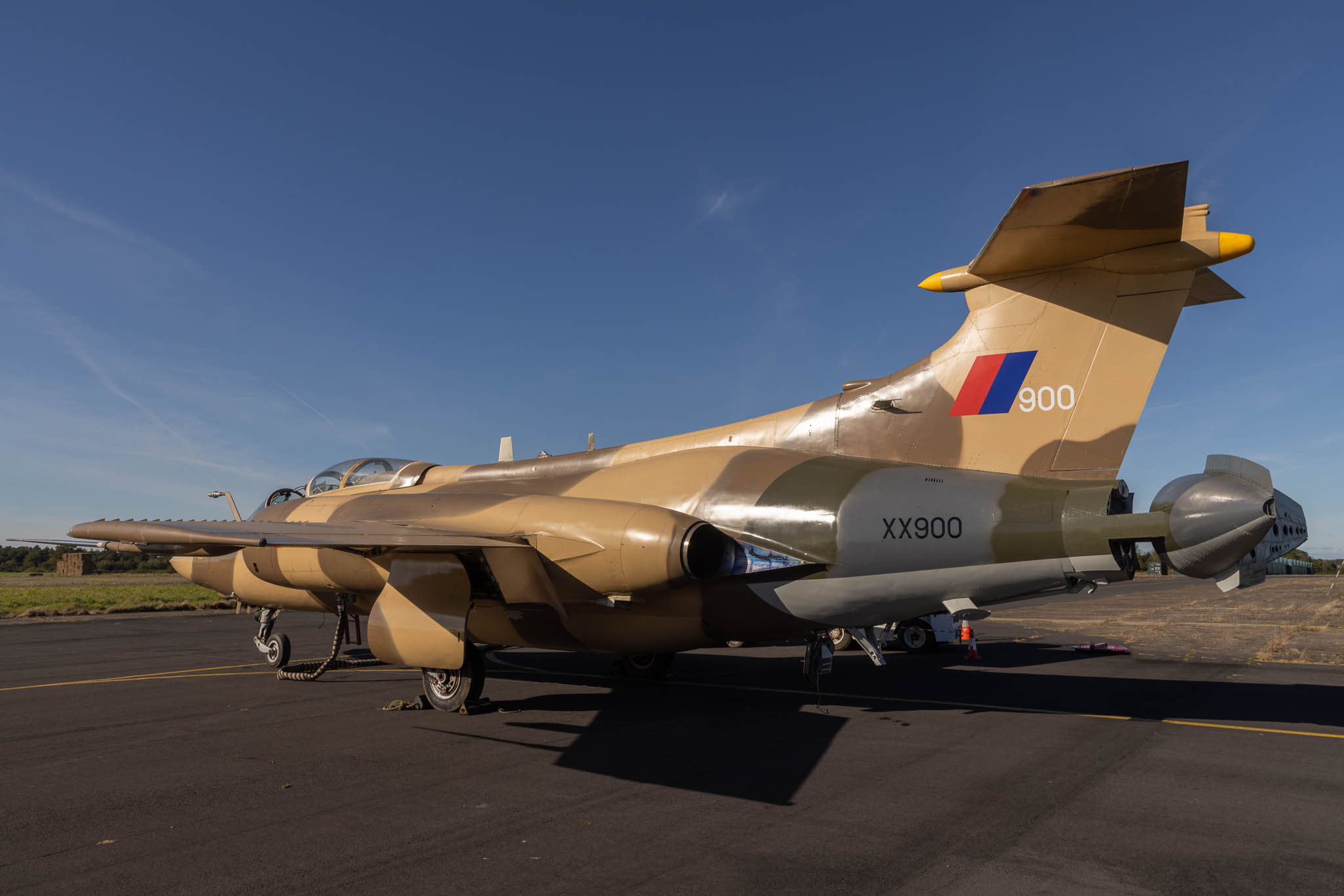 |
The temporary sand camouflage did not extend to the rear of the aircraft, as it was thought the engine's heat exhaust would bake on the paint,
making it much harder to remove after returning from Nevada.
The Buccaneer S.2 variant was equipped with the more powerful Rolls-Royce Spey engine. |
A fitting tribute
At first sight, the new colour scheme looks bizarre and unauthentic. Its only when people find out that XX900 was actually painted in the scheme for the 1977 Red Flag that they begin to appreciate what a tribute it is to the pilots, who flew it at 633mph just 20ft above ground level to evade aggressor aircraft flying combat air patrols above and missile sites below, while undertaking precision attacks on Nevada's test range airfields. Ironically, it was determined that the desert camouflage scheme did not actually give them an advantage during the exercise; it was the aircraft's ability to fly extremely low that made it untouchable.
The ongoing preservation of XX900 by Lee Parker's team is a fine testament not only to the Buccaneer – perhaps the best jet at low level ever produced the UK – but also the brave, highly skilled pilots that regularly flew the aircraft.
Raising money to cover the ongoing costs including insurance to cover engine runs and brake testing is another challenge to keep her running. Fast taxi runs are perhaps beyond the team at this time. XX900 will never fly again due to CAA rules for ex-military aircraft and complex airframes only controlled by hydraulics. |
Looking back: October 2023
Since 2020 I have had the pleasure of following a family of aircraft lovers who have been maintaining and restoring the wonderful former cold war jet aircraft. This is no ordinary fast jet it is Buccaneer S.2B XX900. Perhaps only a few aircraft magazine readers will understand the dedication and enthusiasm of Lee Parker’s team has for this aircraft.
Philip Stevens |
| Left to right: Buccaneer S.2B (XX900) being readied for an anti-det engine run, foiled by a broken H&S Aviation Stad 250 Mk12L Air Power Unit (APU). |
| Left to right: Buccaneer S.2B (XX900) being towed back to the temporary location on the opposite side of the airfield, used to keep eyes away from the finished paint scheme. |
| Buccaneer S.2B (XX900) during a 'night shoot' in the blue hour. |
| For Buccaneer S.2B (XX900), the sand camouflage is now being applied. |
| Buccaneer S.2B (XX900), filler has been applied over the dints. |
| Buccaneer S.2B (XX900), sanding down and de-greasing the undersides, back-breaking work. Chris Kennedy when sanding down he said: "It makes your muscles burn holding the sander upwards to the undersides of the wing." |
| Tony ‘Biggles’ Simpson (Yellow EOD t-shirt) is an EOD bomb disposal expert in real life. "Today I am sanding her down to make sure she is smooth for painting. I am doing the bomb bay because I am used to being on my back under the aircraft. It’s a love affair with this aircraft, I am glad I am with like-minded people." |
| Volunteers sanding down and degreasing XX900 to get the surfaces smooth and clean ready for painting. |
| Lee Parker taping up in preparation of the painting of the undercoat. |
| Steve Maltby an aircraft owner at Tatenhill and formally with Air Livery has now started spray painting the lime green undercoat. |
| Lee Parker giving a hand with the painting. |
| The green primer arrived in April 2022. |
| When sanding down to the original primer Steve Maltby discovered that there were eight layers of paint. XX900 carried the 237 OCU markings, under that the 12 Squadron fox was revealed on the side of the intake. Even the blue and yellow 208 squadron flash could be seen. |
| May 9, 2022, after Covid enforced break |
| Buccaneer S.2B (XX900) inside the cockpit. The front-seat cockpit is more or less complete, the rear-seat is sparsely fitted out. |
| November 2020, just a few days after its arrival from Bruntingthorpe |
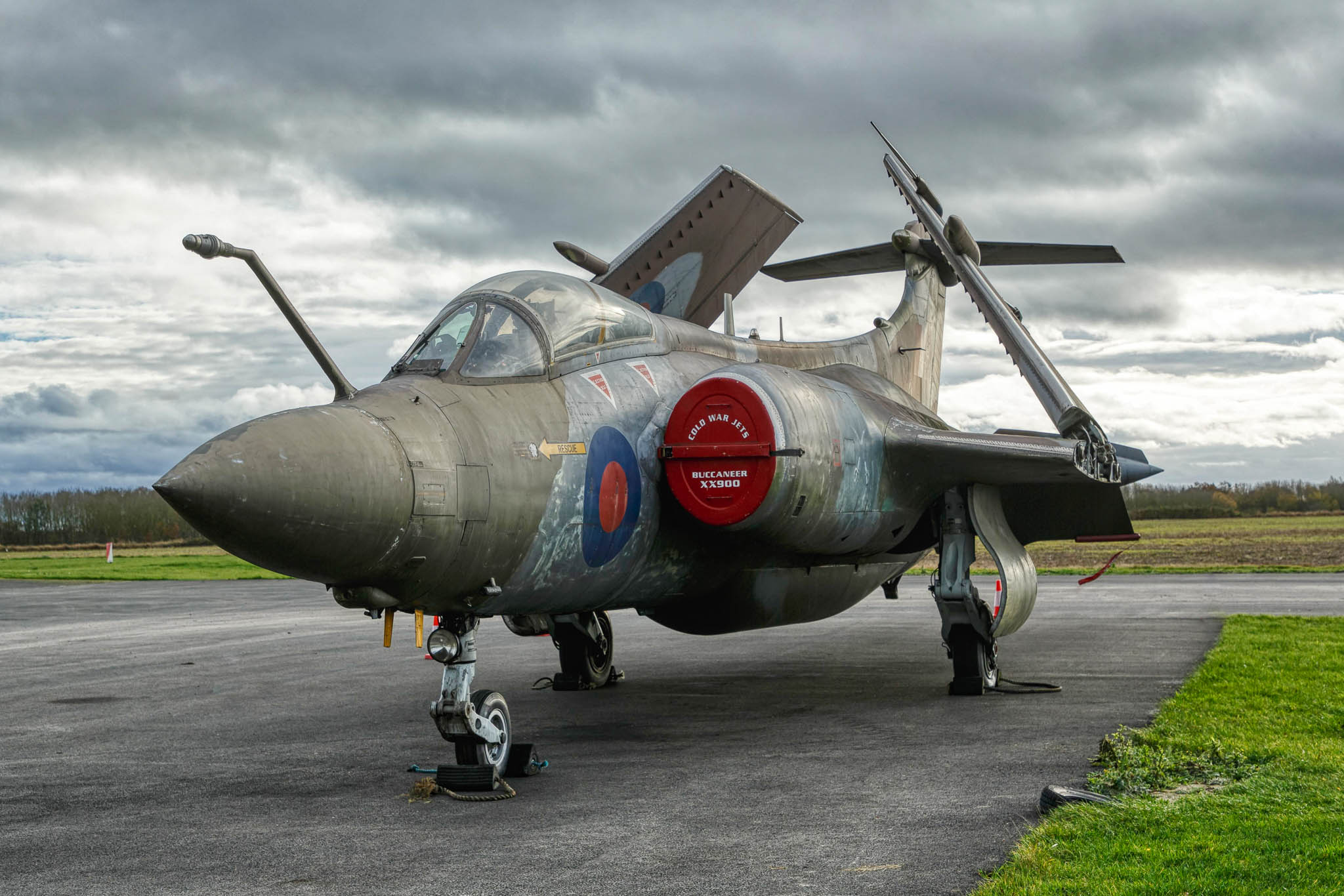 |
A weather beaten Blackburn Buccaneer S.2B (XX900) after twenty years of outside storage, shortly after its arrival from Bruningthorpe. It carried the crossed swords and mortar board marking of 237 Operational Conversion Unit (OCU) from when it was based at RAF Honington.
At Tatenhill XX900 is parked airside and within a few months the preservation team maintenance schedule was subject to COVID 19 lockdown restrictions. Additionally, a large collection of spare parts and ancillary equipment including a loaned Houchin ground support equipment (GSE) also had to be collected from Bruntingthorpe, this time without the expensive Police escort! They needed a shipping container but Tatenhill managing director, Mike Shelton immediately offered a large World War Two hut on the airfield, which was ideal, once they fitted a new door and installed new lighting, for all their equipment and large stock of spare parts.
Mike Shelton, managing director, with his son Paul Shelton engineering director of Tatenhill Aviation took over the running of the airfield from Allied Breweries in 1987 who had operated from Tatenhill since 1959. They were very keen to give a home to the historic jet at the former RAF Tatenhill constructed in 1941. |
19 years with the RAF
XX900 was the last but one Buccaneer to be leave the Hawker Siddeley Aviation production line at Brough. It flew for the first time on October 22, 1976, and was delivered to RAF Honington for 208 Squadron a month later. 208 had reformed on July 1, 1974, to become the RAF’s fourth Buccaneer squadron. It was to move to 216 Squadron and then 12 Squadron at RAF Lossiemouth and back to 208 Squadron by 1983.
At this time XX900 took part in Operation Western Fox firing live Martel, a sea-skimming anti-ship missiles against target ships off the coast of Florida. Later in 1983, she was one of six aircraft to trial the AN/ALE-40 Counter Measure Dispenser System (CMDS) which releases chaff or flares. They were fitted in a hurry under Operation Pulsator to support elements of the British Army stationed in Beirut. The AN/ALE-40 dispensers are still attached to each side of the rear fuselage.
In 1986 it received an avionics update at BAe Woodford and was now able to carry BAe Sea Eagle upgraded anti-ship missiles. It was back with 208 Squadron at RAF Lossiemouth by 1987, 237 OCU and finally 12 (Bomber) Squadron, when fitted with the original S.1 (smaller) wingtips. Its last flight to St Athan for disposal was made on April 6, 1994.
|
Dave Walton the owner of XX900
Many thanks must go to David Walton who had the insight to save this jet from the scrap merchants in 1994 and for his continued support of XX900.
He has invested time and money in heritage aviation preservation. I asked, what is your motivation and reasons for doing this? "I’ve always had interest in anything mechanical – cars, trucks, heavy construction vehicles and aircraft As a family owning an airfield, I have had an ideal opportunity to preserve and operate historic aircraft and also enable others to do so. The fun is always in bringing these old artifacts back to life – I am not particularly interested in static or ‘dead’ items."
What are your future plans or ambitions for aircraft you have (particularly Buccaneer XX900 at Tatenhill) or for future acquisitions or even disposals? "The Cold War Jets Collection is still in limbo since moving to an area on the edge of the airfield. This was as a result of a new tenant taking a lease on most of the airfield from my family business. The Buccaneer will remain at Tatenhill for the foreseeable future and I don’t have any current plans to procure any more aircraft exhibits." |
 |




